


Cody Breese Thomas
Your Conscience
Porcelain, Bronze, Wax, PLA
Your Conscience marries traditional sculpting with digital fabrication. By rendering communities of caricatures from porcelain and bronze, this project will employ 3D scanning, 3D printing, and traditional firing and casting techniques. Inspired by the moral paradoxes of our time, this project explores the convergence of tradition and modernity, evoking wonder about humanity’s relationship with nature and myth. Utilizing tools such as 3D scanners, resin printers, and investment casting and atmospheric firing, Your Conscience will include relatable gestures and recognizable emotions, aiming to elicit nostalgia and contemplation through dynamic compositions.
Cody Breese Thomas is a ceramicist from Muskegon, Michigan. Through clay, he examines concepts such as nostalgia, morality, & telos in an effort to understand the fidelity of human connection & the unraveling of social traditions. Currently pursuing a Bachelor of Fine Art in ceramics & graphic design at the University of Nevada, Reno, Thomas utilizes elements such as texture, gesture, line & levity to probe the nuances of society’s moral cognition. Beyond his studio practice, he is also president of Tuscarora Pottery School, where he assists in perpetuating the communal nature of pottery.
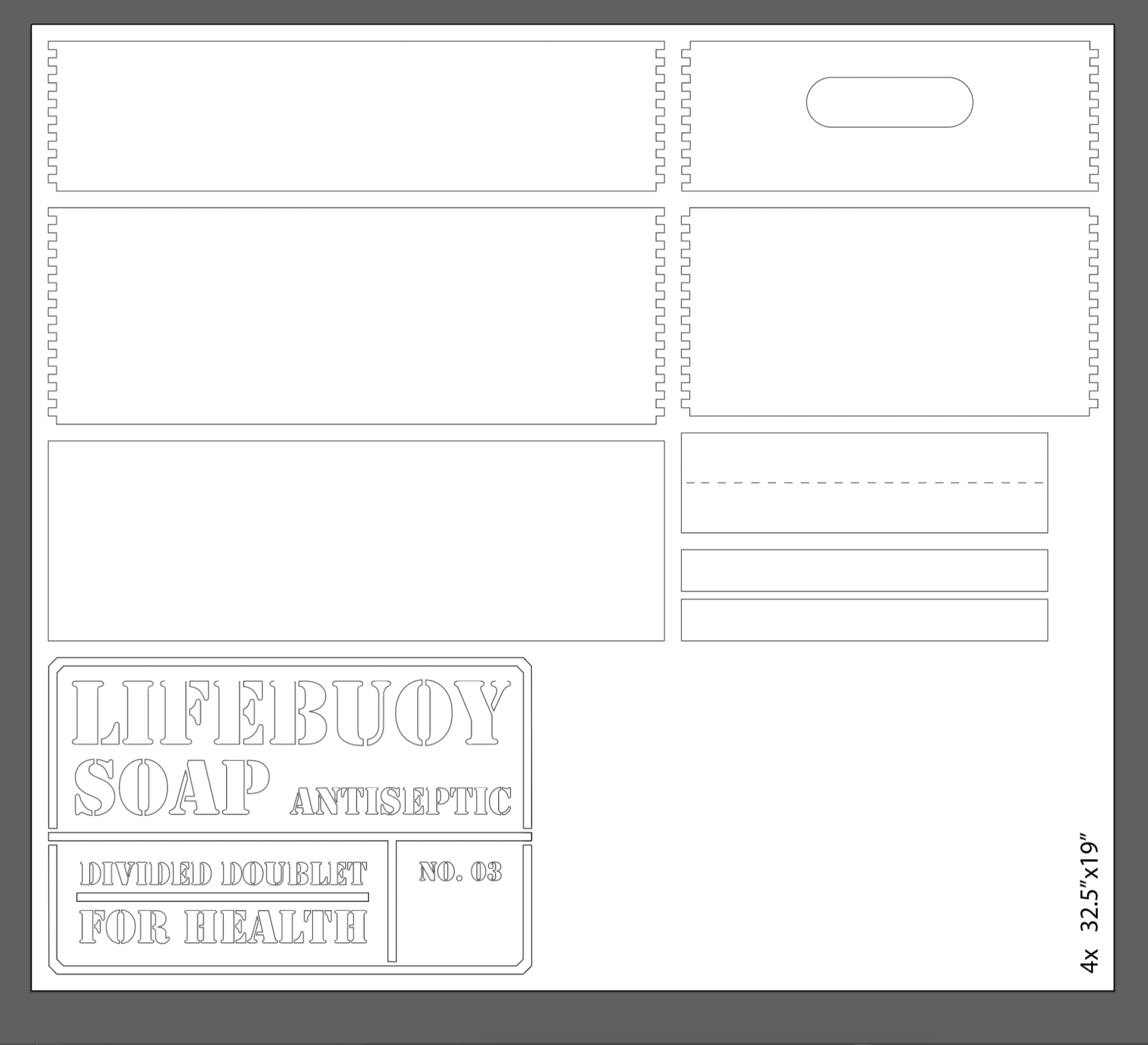


Ashley Brock
Soap Boxes (No. 03)
Cardboard, adhesive, spray paint
Like Warhol's Brillo Boxes, Soap Boxes calls for a reevaluation of values. Traditionally, a soapbox has been a platform for self-expression, yet it also evokes the phrase “get off your soapbox,” highlighting the need for genuine discourse over self-righteousness. Soap Boxes transform these typically “loud” objects into quiet, reflective art objects.
Influenced by life's transient nature, Nevada-based artist Ashley Brock draws inspiration from everyday observations and experiences. She works primarily with abandoned or discarded objects found in proximity, using her practice to explore complex relationships between self and other. She received her BFA from the University of Nevada, Reno.
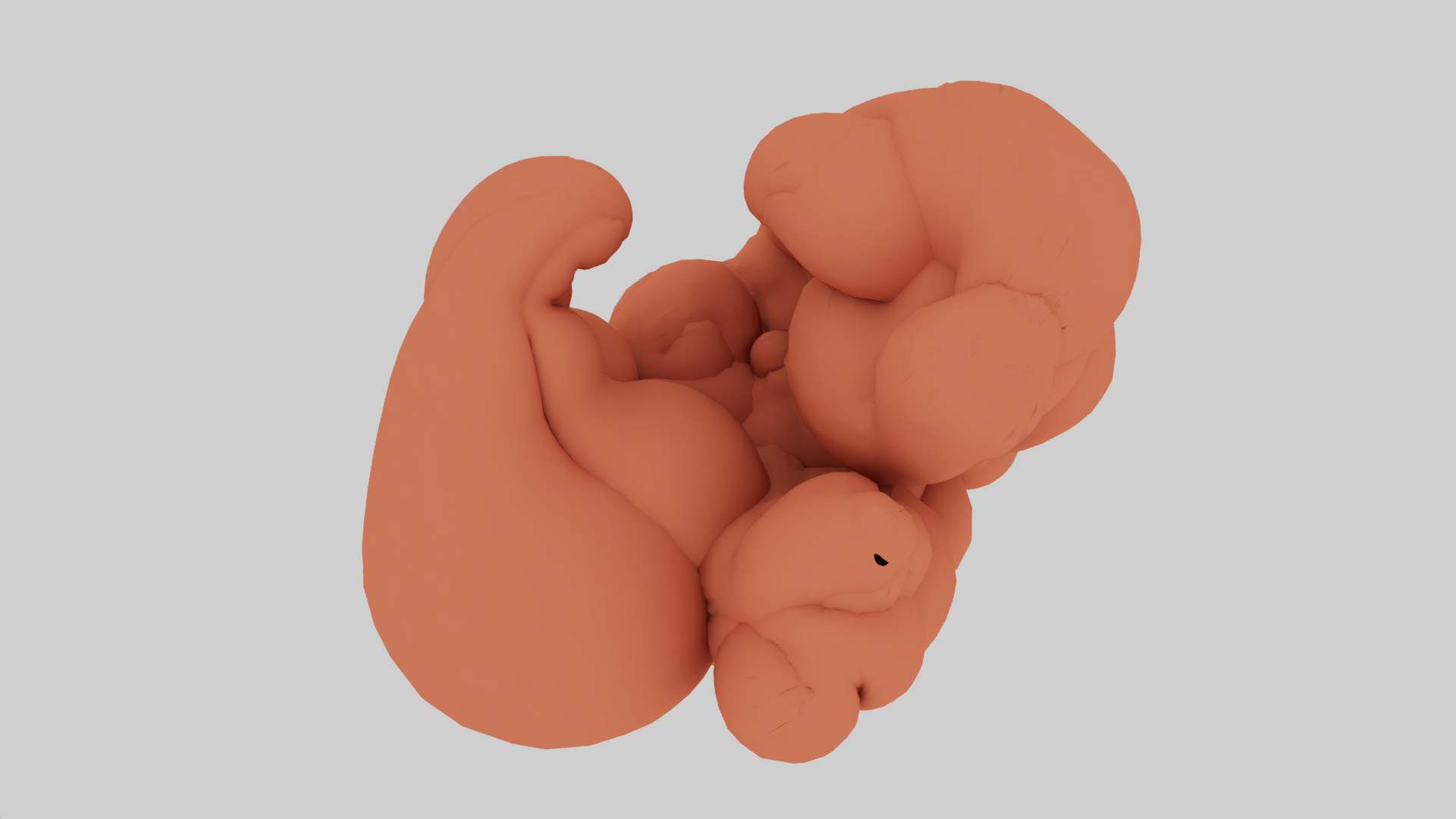
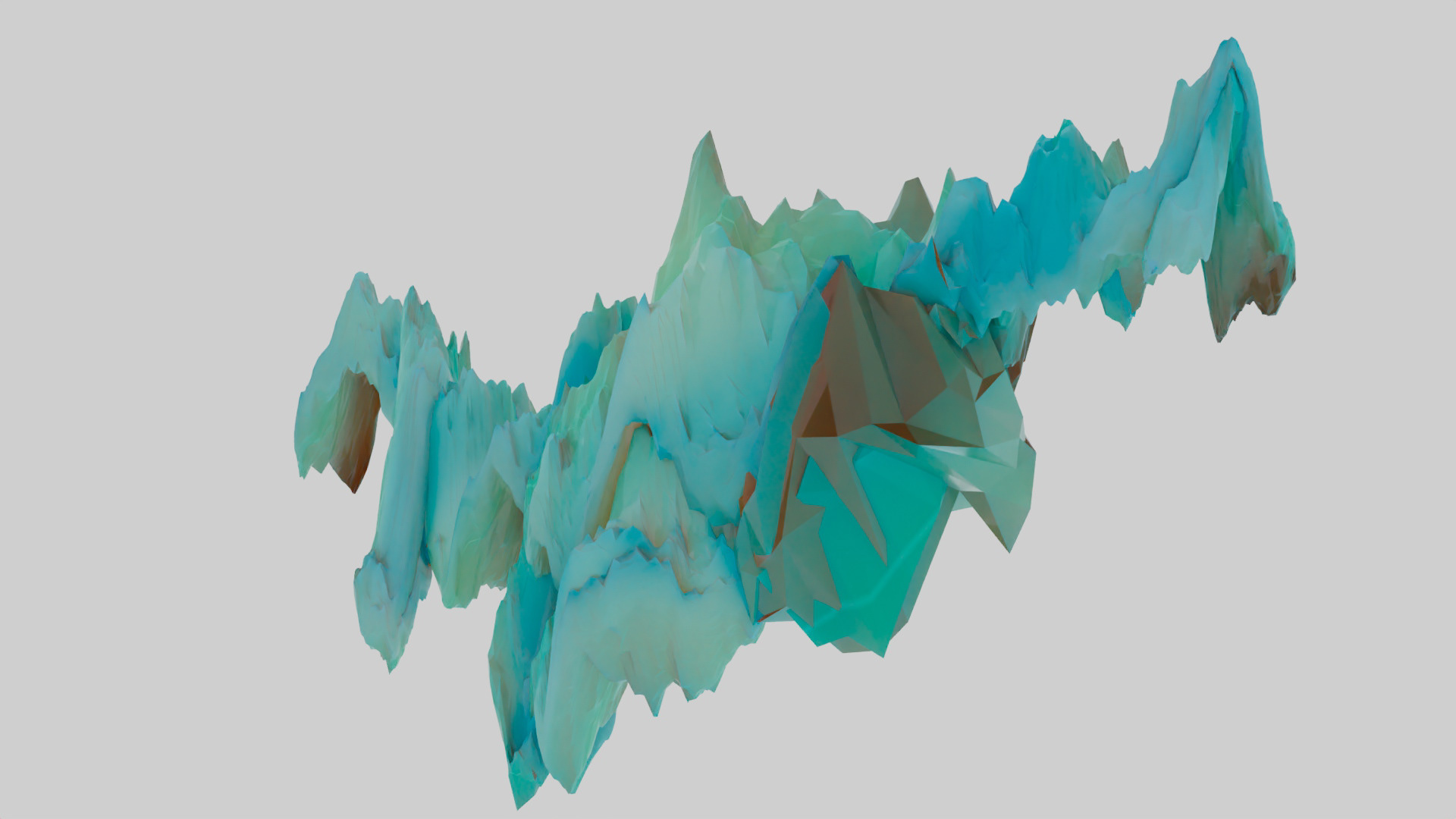
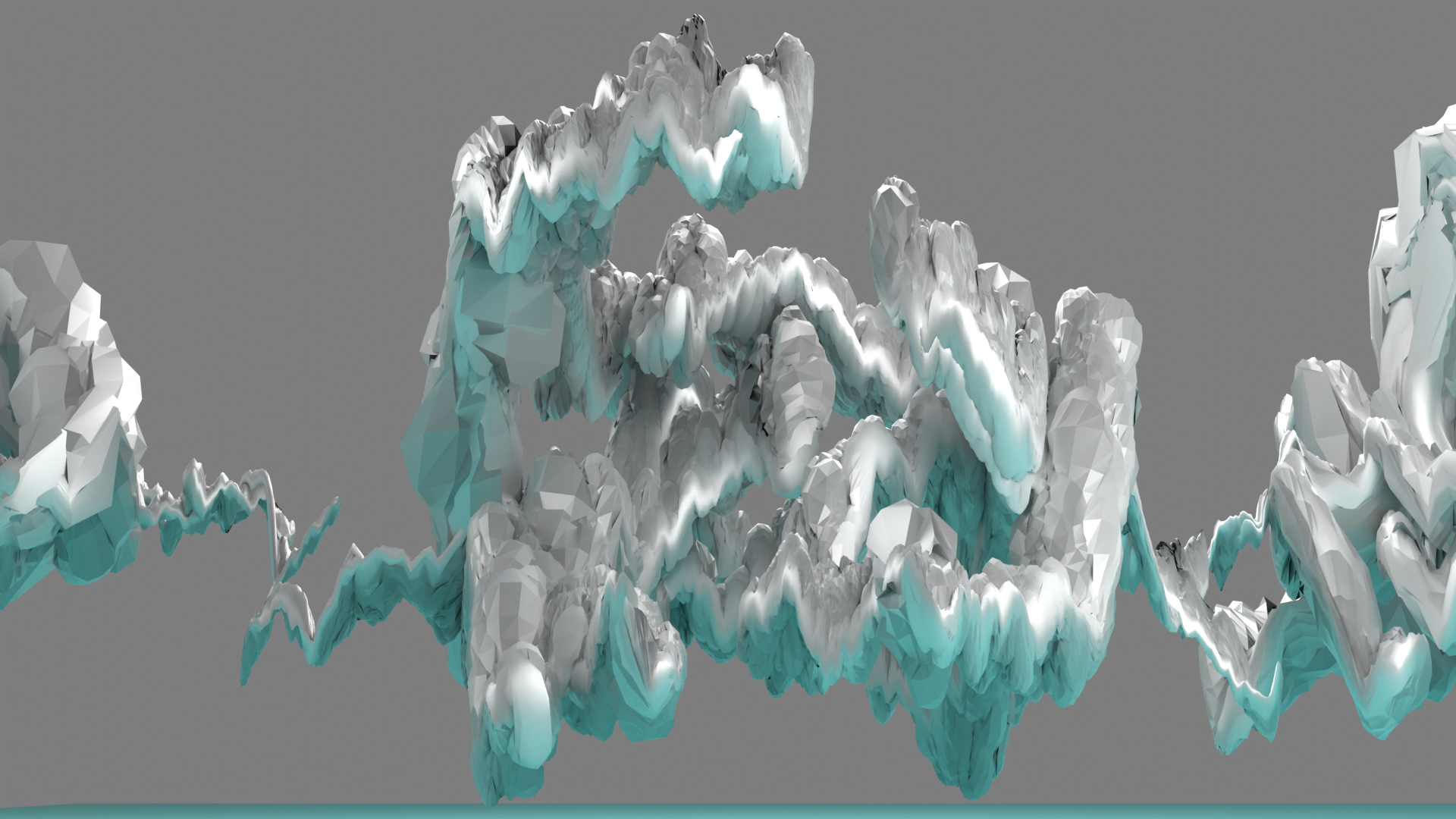
Tyler Calkin
Handshake Protocol with Atmospheric Disturbance (19:45_10.14.2024)
Aluminum, PLA, and OBJ
This work is a telematic portrait of collaboration across the project’s continent- and ocean-spanning locations. A 3D model generated from motion capture data of an embrace between two people acts as a base form; a prior physical interaction becomes the substrate for current remote interactions. Atmospheric data from Reno and London were used to populate input fields for simulation systems within Maya, deforming the model into a data visualization of multiple bodies and environments. The resulting model was 3D printed in PLA and cast as an aluminum sculpture, and exists simultaneously as a digital object.
Tyler Calkin is an interdisciplinary artist and educator who explores the embodied experiences of technology through motion capture, 3D printing, augmented reality, and machine learning. His work has been exhibited, screened, and performed at Lincoln Center; Mount Sinai Hospital; the New York UN Headquarters; AIIMS, New Delhi; and the WHO Place des Nations in Geneva; as well as in London; Berlin; Beijing; Copenhagen; Changwon, South Korea; Aguascalientes, Mexico; Valencia, Spain; and many other physical and virtual locations. Tyler received his MFA degree from the California Institute of the Arts and is currently an Associate Professor of Art and the head of the Digital Media Area in the Department of Art, Art History, and Design at UNR.
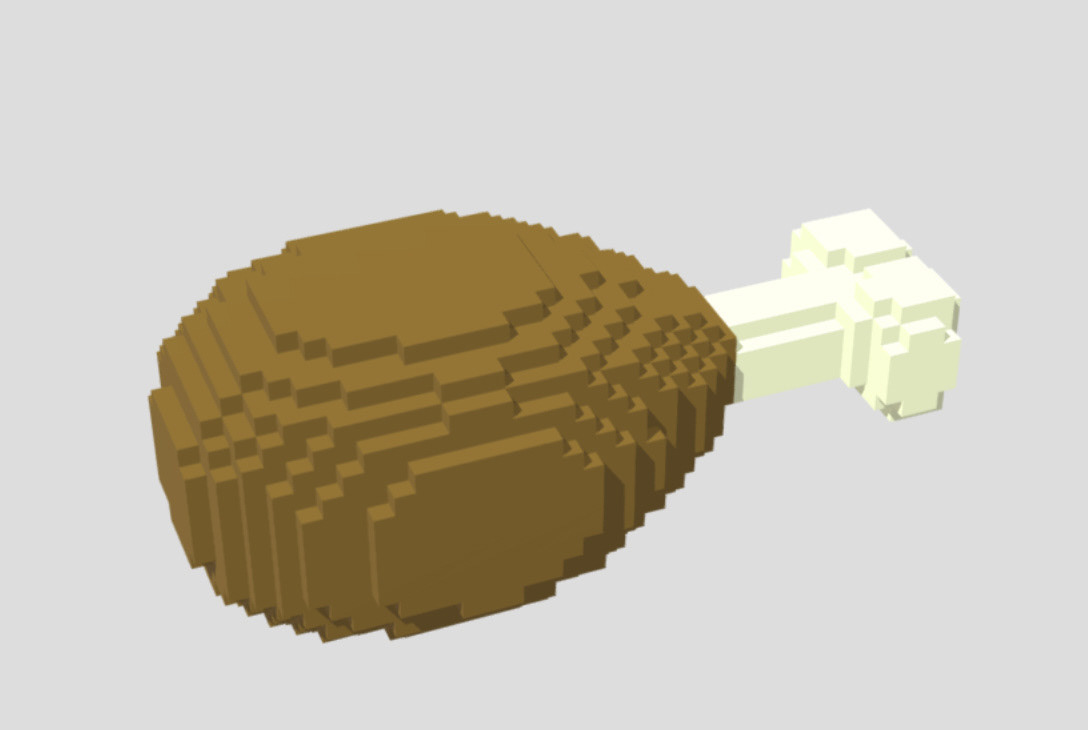

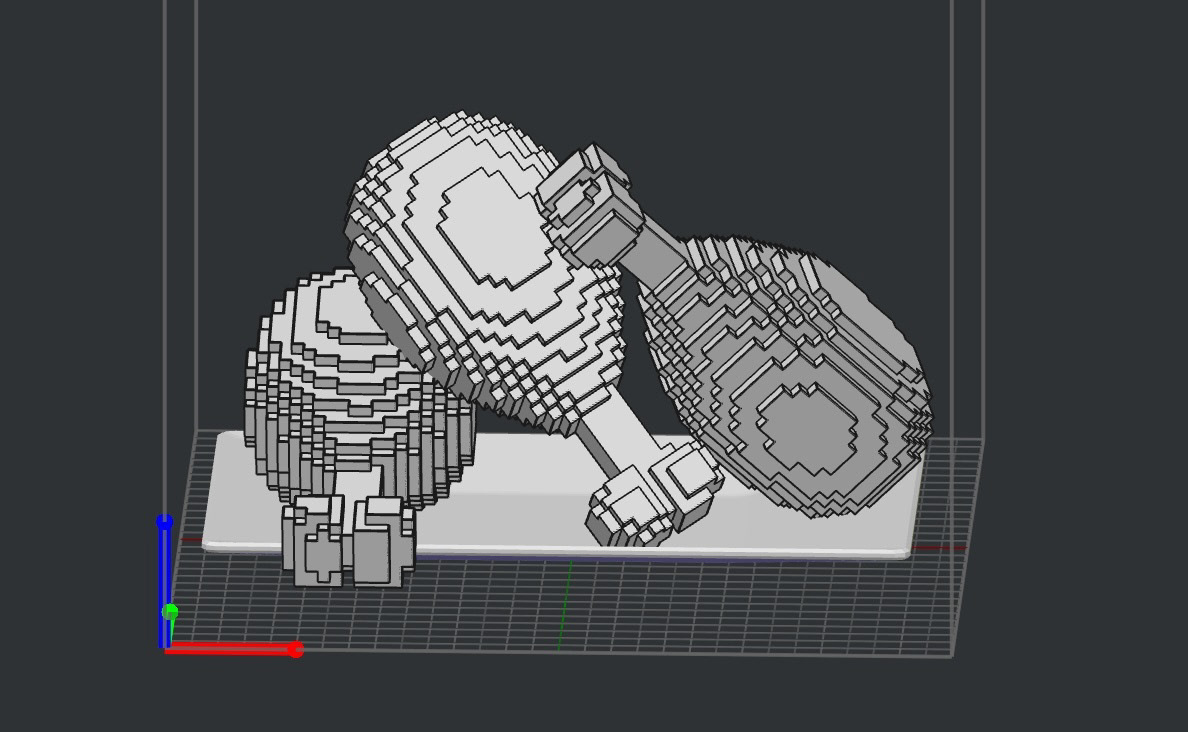
Kayla Dent
Synthetic Appetite
3D Printed Sculpture
Digital consumption is the inspiration for this piece, with chicken legs as the representative factor due to their easy distinguishability. When portrayed in media, these specific cuts of meat are often grandiose and "done-up" for advertising, but rather disappointing in reality. The ways in which we consume media are also great in theory, with easier access to social spaces and construction of communities, yet online consumption often falls short to real-life interactions and could never replace genuine human connection.
Kayla Dent is an artist who explores the connection between the digital and physical worlds. Her work captures the strange mix of nostalgia and unease brought on by the rapid changes in technology. Using tools like 3D printing, 3D modeling, and interactive designs, she focuses on themes such as overconsumption, artificiality, and how technology shapes the way we remember and experience the world. Kayla’s art bridges the gap between the virtual and tangible, offering a fresh perspective on how these two realms collide.
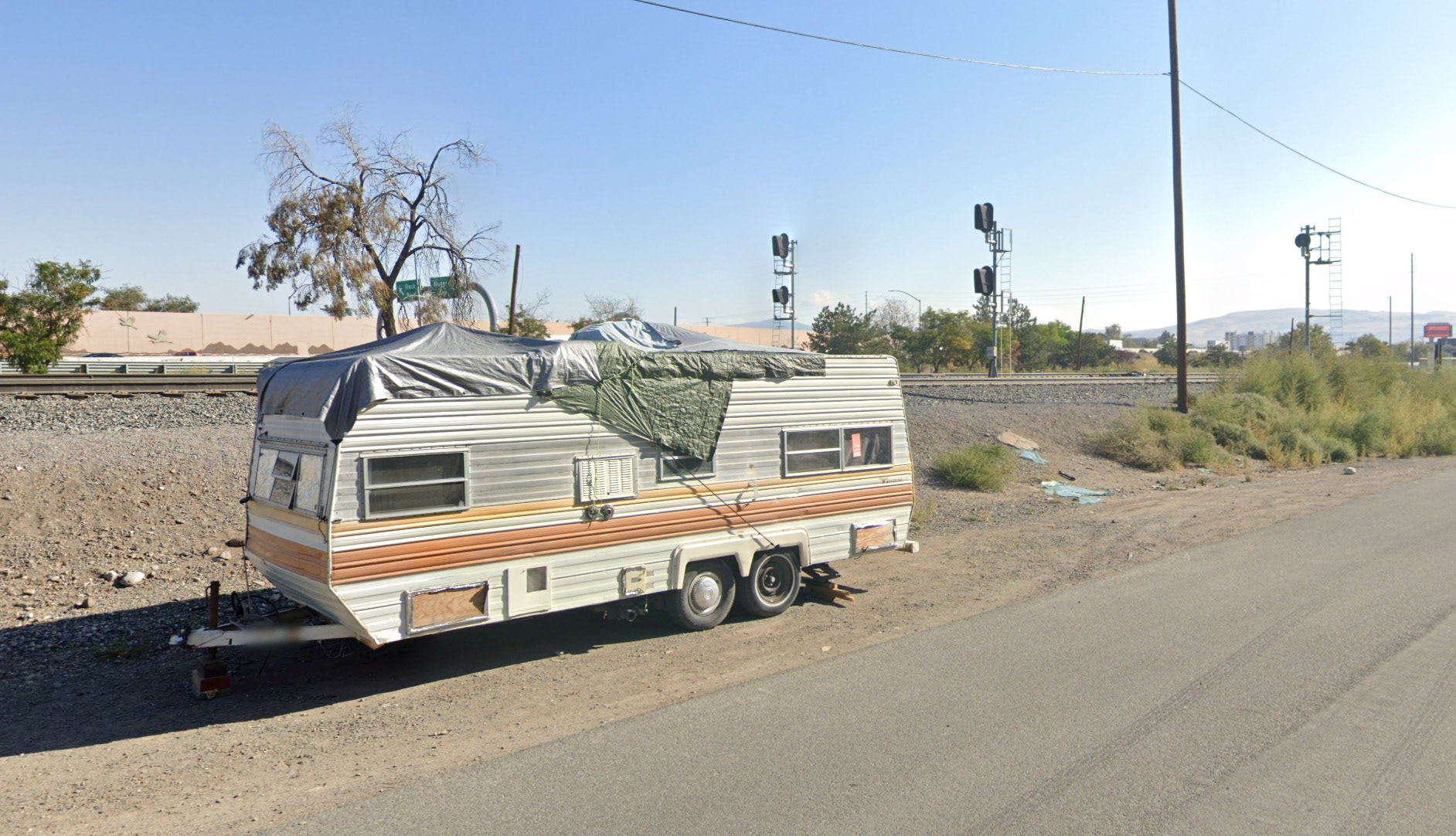
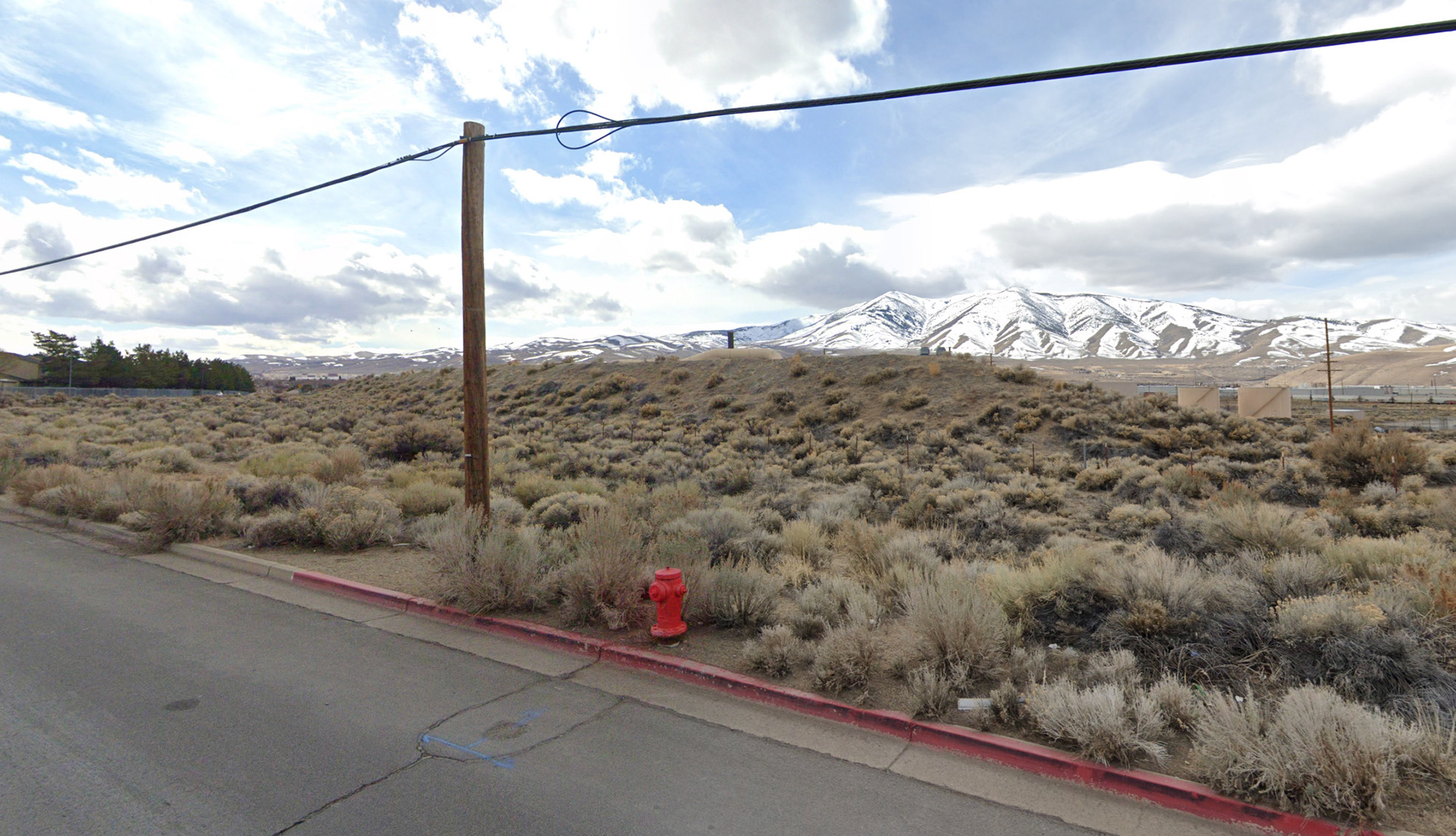
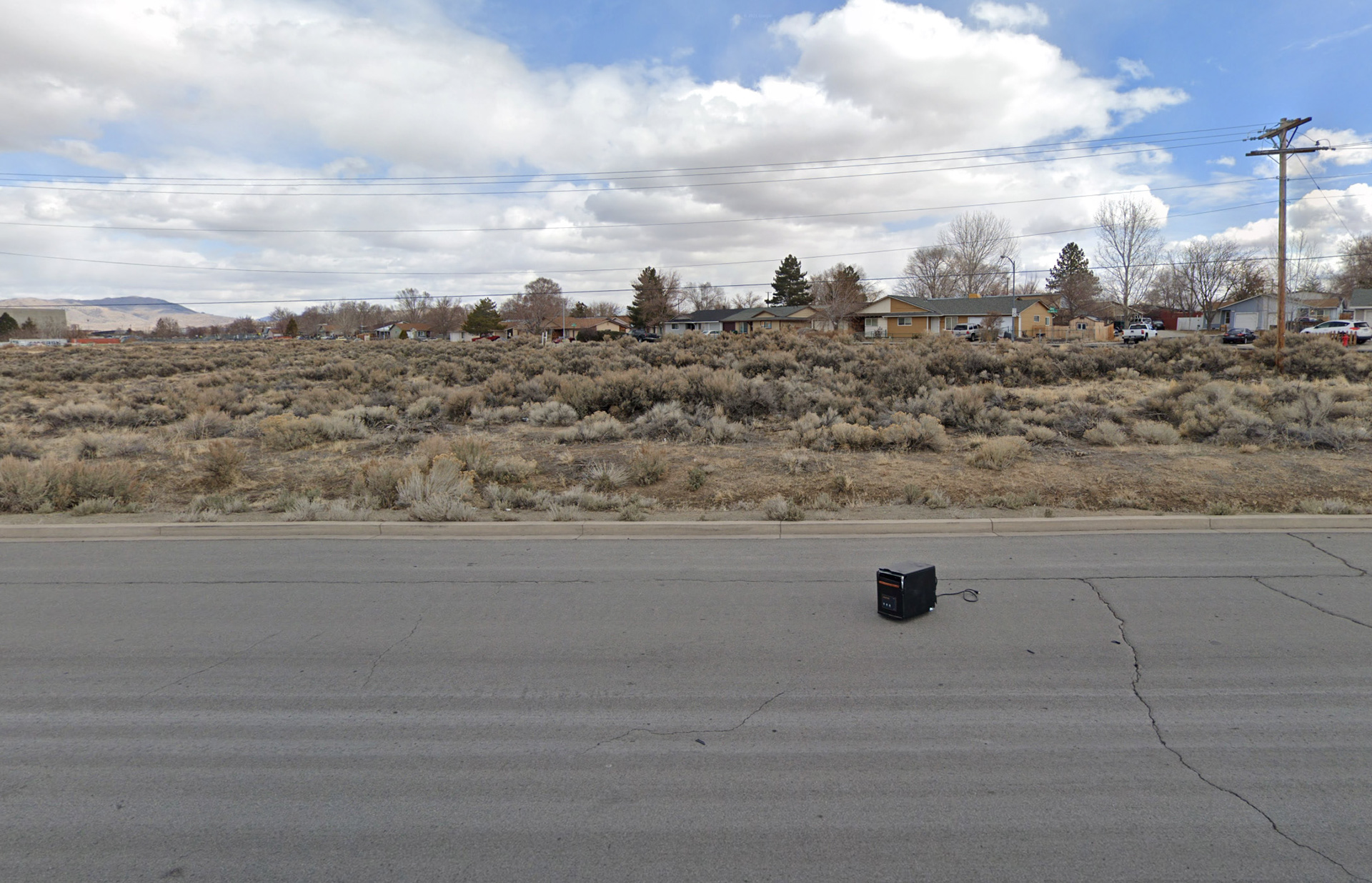
Monika Drabot
Road Trip 1 & Road Trip 2
C-Type Luster Photo Paper
The Artwork Road Trip is a digital journey conducted virtually on Google Maps, taking screenshots (photographs) throughout the journey. It explores Reno through its back streets and recycling centres, capturing evidence of human consumption. The project highlights the oddities found in the landscapes and the impact of human intervention in the urban environment. It aims to reveal city life's unseen and, perhaps, slightly undesirable realities. The layout creates a storyboard, where one image connects to the next, establishing relationships between spaces, objects, and events. The display is printed, and the layout suggests you can click to expand and learn more about the depicted locations. It serves as a visitor's guide to the Reno landscapes and sights.
Monika Drabot earned her MA in Fine Art at Chelsea College and BA (HONS) in Photography from Arts University Bournemouth, UK. She has received awards such as the Source Magazine Graduate Photobook Award, The Anne Corkett Prize for Photography, and was shortlisted for the Pride of Guernsey Award for Arts Contribution of the Year. The artistic practice revolves around themes of social structures, urban environments, and the significance of seemingly ordinary objects or moments. Her artworks evolve through the mediums of photography, light, books, and installations, some of which invite interactive engagement. This immersive approach draws viewers into the realm of the everyday, while also prompting profound inquiries about temporal perception and our interconnectedness with various surroundings.
Matt Franks
A strange dust lands on your hand
V5 Resin
The small translucent model of a nuclear fire ball caught in its later stages of detonation is based on one of the series of tests in Area 5, Nevada in 1957, code named ‘Plumbbob’ Priscilla was a 37 kt device. The miniaturization, stylization and souvenir quality of the sculpture and use of its name suggests a human need to reverse the scale of something terrifyingly incomprehensible into something comprehendible, strangely beautiful, and ‘safe’. Based on dozens of photographs and videos the object is scanned from a 12-inch handmade reconstruction and then 3d printed. Since 1951, more than 600 nuclear devices were detonated at the Nevada Test Site.
Franks’ work engages with the relationship between high and low culture, conflating pop imagery and ‘classical’ styles of sculpture and art deploying disposable materials and repurposed objects. Recently his work has begun exploring economies of scale and production by combination of digital technology and analogue practices. Franks’ work has exhibited internationally, and his work is in numerous collections including the British Council. Franks has featured at major galleries and museums in Africa, Europe, UK, USA, China, Australia, New Zealand and he has completed residencies in Africa, USA and New Zealand.
Daniel Giroux
of Joe Brown
Polylactic Acid (PLA)
Joe Brown was an incredibly creative and gentle man, who expressed his passions through painting, music but most of all his incredible model train set. Joe Brown passed away in 2024, leaving his train set silent and motionless. Through 3d scanning and printing, this piece is a an attempt to preserve part of that, a beautiful world, smaller and simpler. This is a collection of memories of Joe Brown.
Daniel Giroux is a Lake Tahoe based multi-media artist and educator. His work explores the borders where digital and analog worlds meet, through the exploration and the translation of those spaces. Daniel received a BFA from the School of the Art Institute of Chicago in 2016, and then worked in both artistic and commercial fabrication after. He is now faculty for the Department of Art, Art History and Design at the University of Nevada, Reno, teaching in the area of digital fabrication.
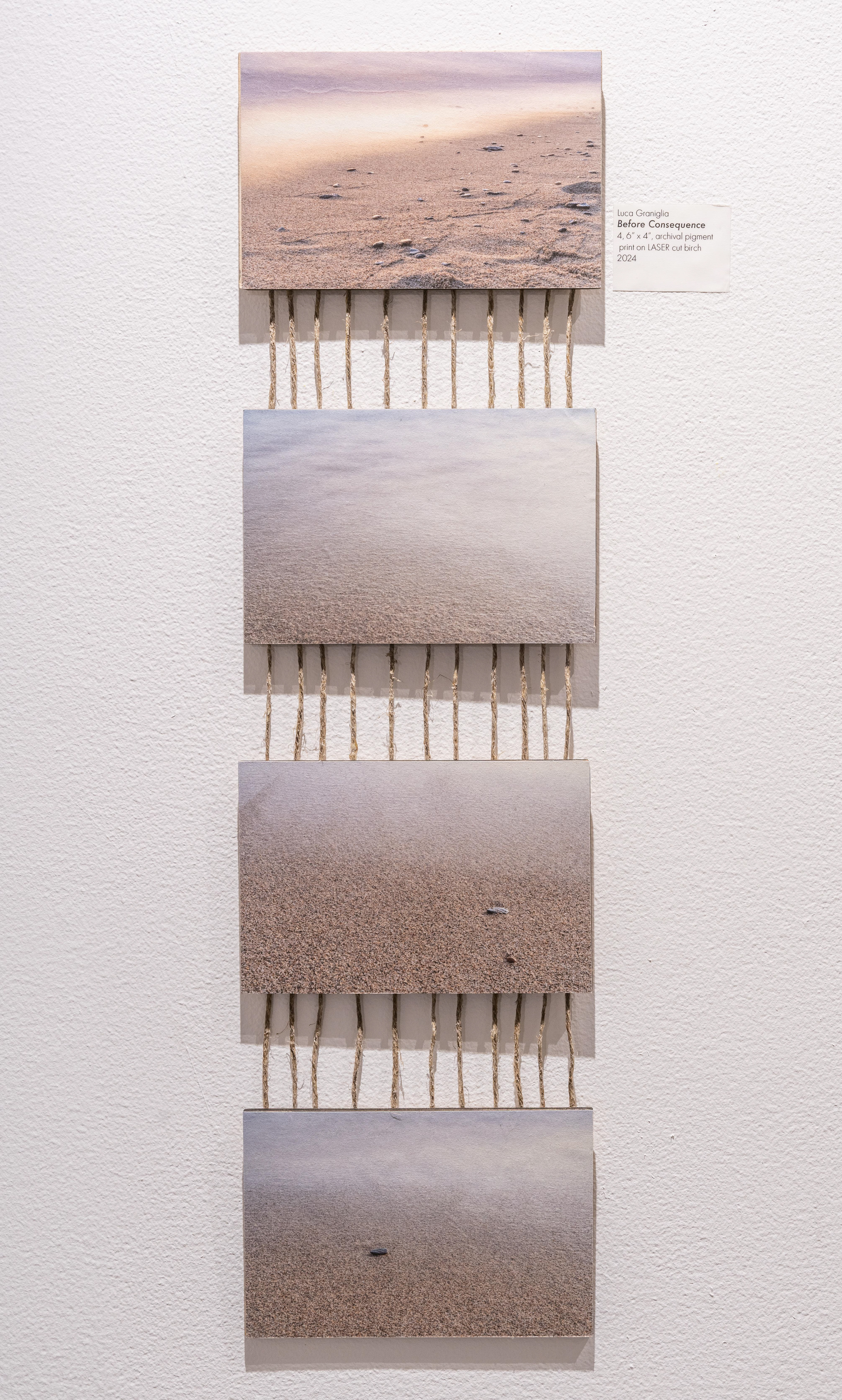
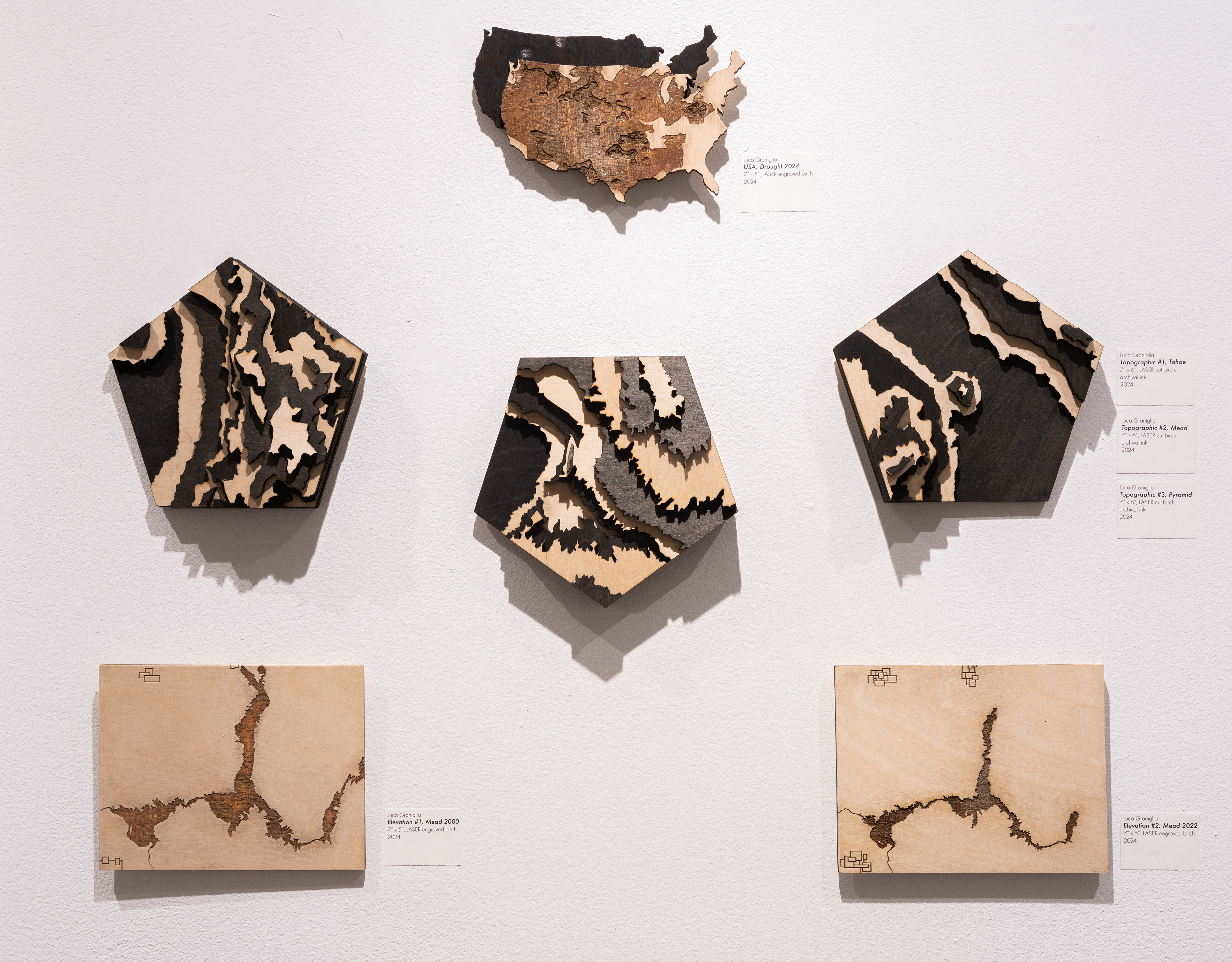

Luca Graniglia
Mapping Consequences: Topographic series
LASER cut birch and archival ink
I have fond memories of Lake Mead that have been tainted by the decline in the water levels over the last twenty years. Comparing the shadow of Pyramid Lake and the prosperity of Tahoe to that of the decline of Lake Mead. Using a combination of sculptural maps and photographs, this project aims to create the connections of nature, decay, direction, and time. We use maps to visualize the “truth.” This body of work further aims to subvert the expectation of the “truth” to the possibility of decay. Against what is the facade of prosperity. In combination with information and maps sourced from USGS and NASA Observatory. When is it ok to approximate the lines we draw?
Luca Graniglia is a visual practicing artist based in Nevada in the United States. 23 years old, They were born and raised in the city of Las Vegas with two older siblings and parents. raised with an artistic spirit, they would have a very nice childhood but a tumultuous adolescence. During this time, Luca was diagnosed with PTSD, BPD, and MDD. They then became attracted to the medium of photography and the ability to capture a moment in time; as someone who would often forget the good moments. They then went to study at the University of Reno Nevada with a major in photography. It was there Luca learned the interconnectedness of the visual arts. Learning and practicing multiple mediums since then including but not limited to painting, drawing, digital art, sculpture art, and book art. Continuing to live with an abundance of negative and traumatic experiences, Luca wishes to spread and capture as much positivity as they can in this life; while also not shying away from the issues that concern them and others.
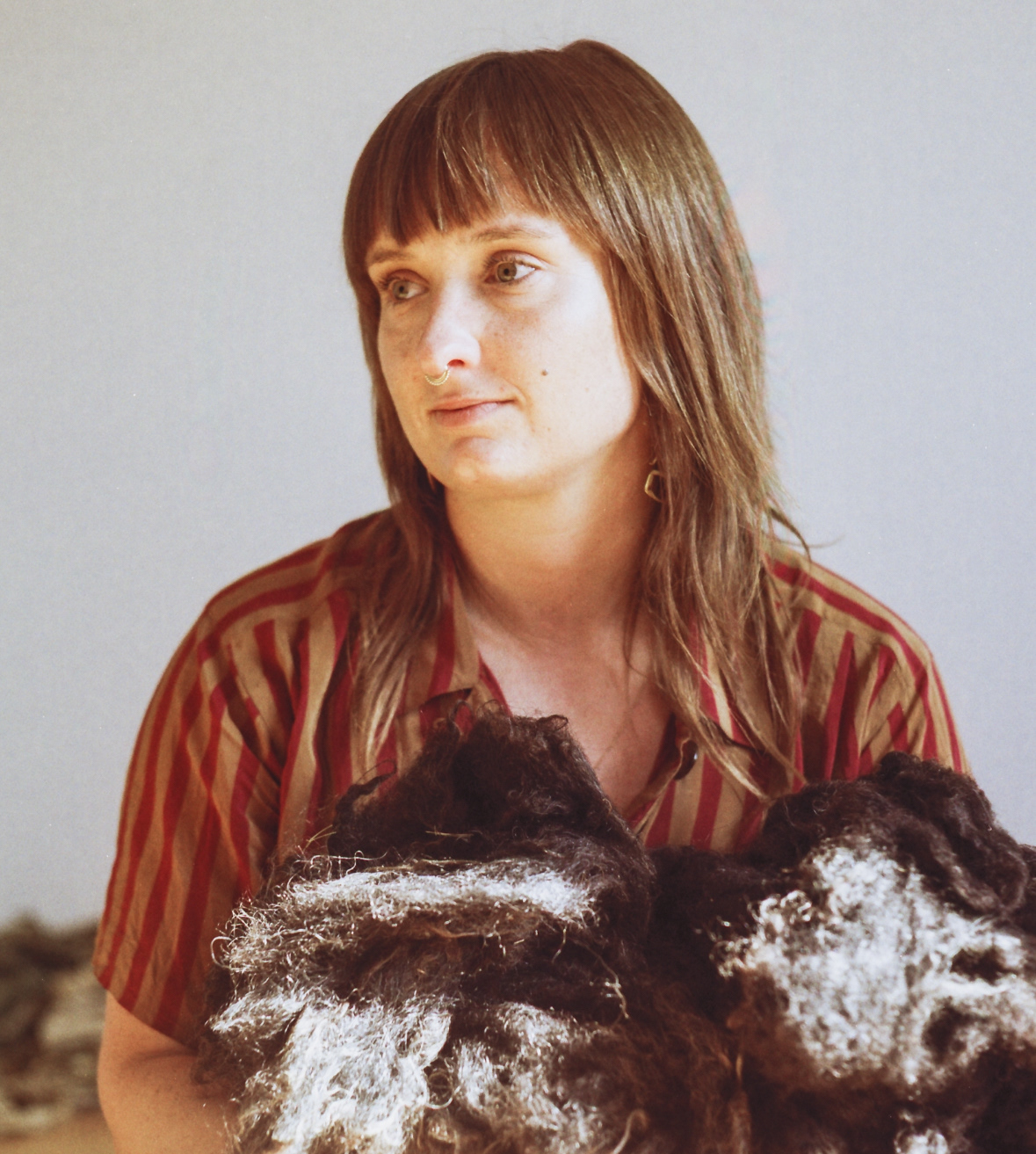

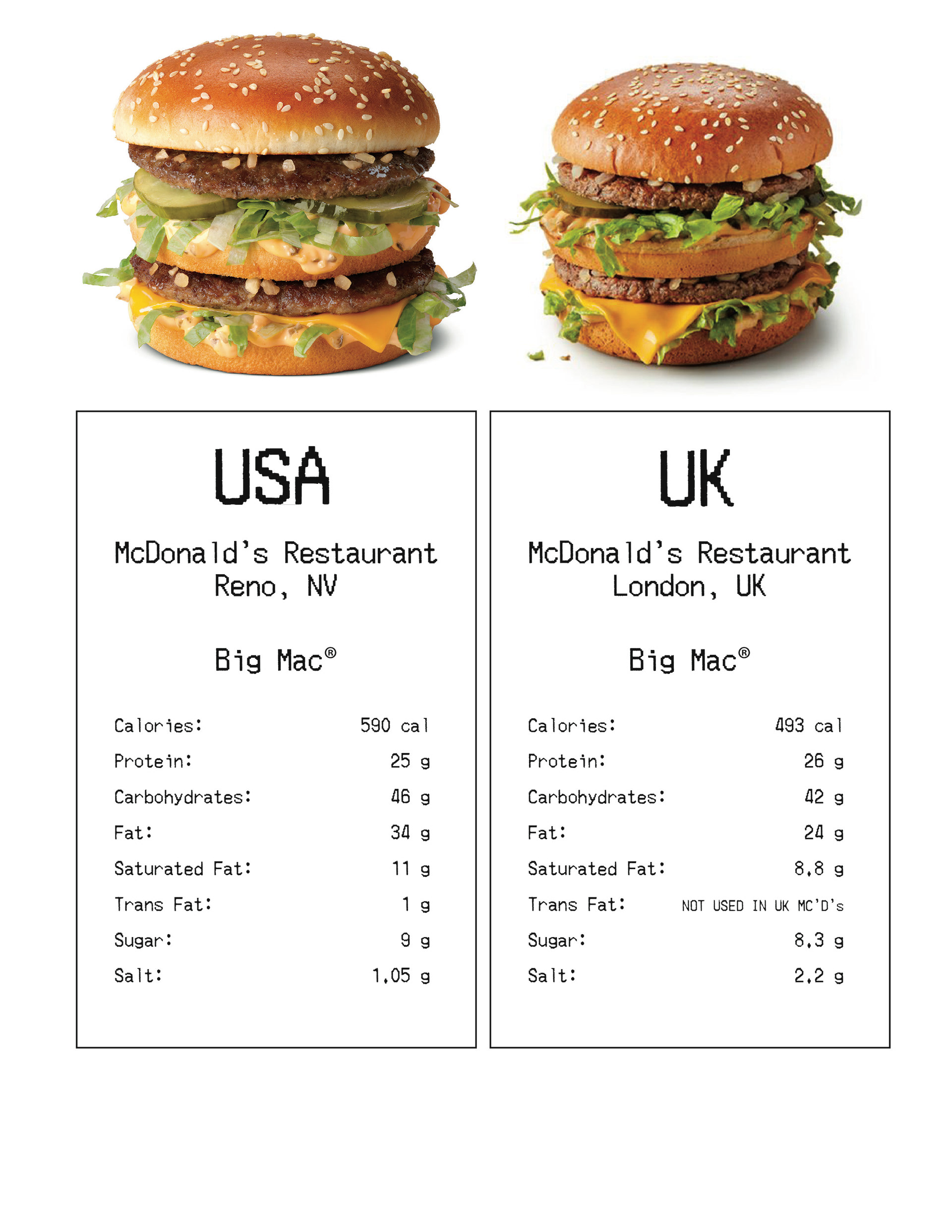
Ivy Guild
Trans-Atlantic Heartthrob
Installation, Digital Media
Sure, the UK left its mark on the United States through colonialism, imperialism, and all that entails. But, the US has exported the McDonald’s Big Mac to 100 different companies for a combined sale of over 990 millions Big Macs sold ever year (approximately 2.4 million/day). Trans-Atlantic Heartthrob (2024-25) demonstrates the care that goes into assembling the less than heart-healthy ingredients that go into the US & UK Big Macs. Can you guess what the US special sauce is? Hint: it is an ingredient that is banned in only a handful of places but that the World Health Organization has warned the world against.
Ivy Guild is a Reno-based interdisciplinary artist and educator invested in researching a post-Anthropocene world to illustrate speculative environments left behind after the 6th Great Extinction. She immerses herself in queer ecologies of a post-human world, searching for environmental justice in anthropomorphic vignettes. Solastalgia propels her to keep shaping sanctuaries and evolved beings that not only survive, but thrive amidst human detritus. Her work manifests in multimedia installations that merge organic and inorganic materials. Guild’s recent work engages fiber practices centered on natural dye research, and biological mimicry of desert dwellers such as insects, cacti, and geological formations. Ivy Guild is an Assistant Teaching Professor and area head for Visual Foundations in the Department of Art, Art History and Design at the University of Nevada, Reno. Her work is in the permanent collections of San Diego State University and Smith College, amongst others. She has forthcoming solo exhibitions in Reno and Nashville.

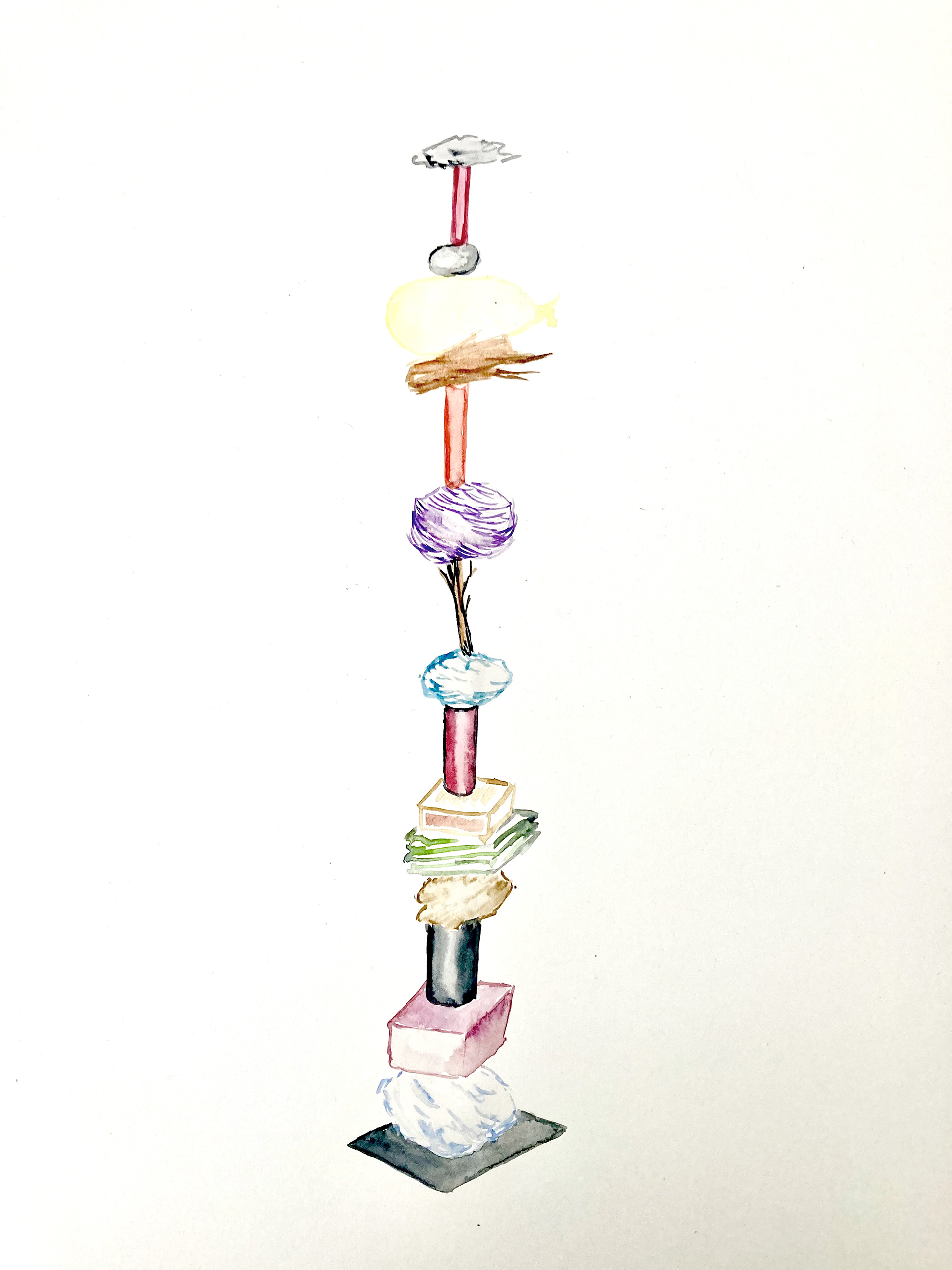
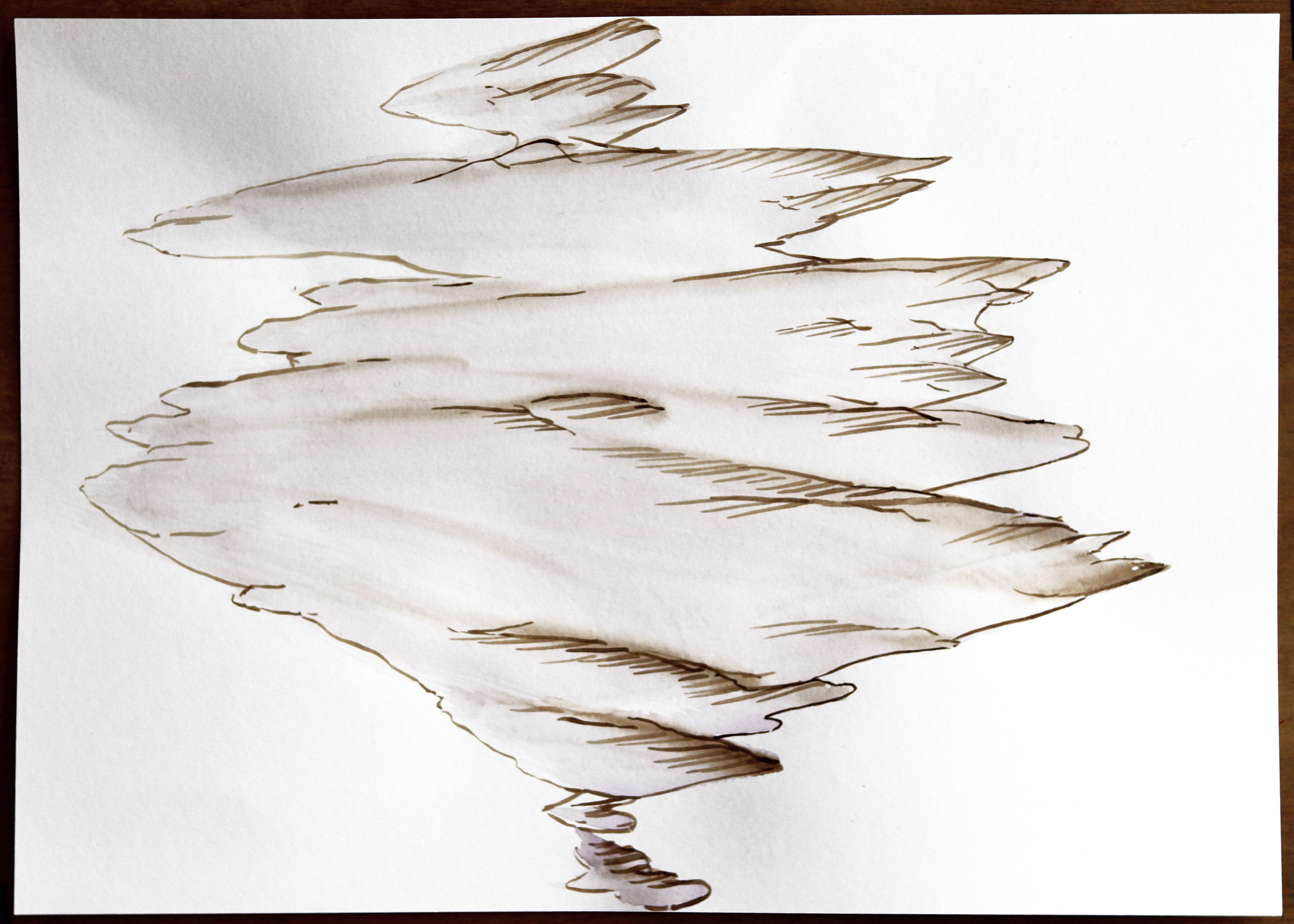
Tina Gverović
High Stakes
Series of 17 aquarelle on paper, each 42x28cm. Sculpture composed of a range of materials such as: match box, piece of rubber, paper, textile, wood, metal, plastic, balloon; dimensions variable. Zund print, size open to interpretation.
The sculpture is installed as a vertical sequence, referencing the legendary work Endless Column created by the sculptor Constantin Brâncuși. The ‘stacking’ accentuates the idea of rising above the everyday, raising the horizon both physically and fictively, and the possibilities of conceptualizing and perceiving a better vision of the future, one that is more ecologically and culturally aware, a space of intersection, overlapping, inter-, trans- and cross-. The intention is to explore the wider implications and the inherent potential of the idea of inter-connection both within and between materials and humans.
Tina Gverović works with installation, drawing, painting, sound, text, and video. Her work – often in the form of immersive, disorientating installations considers affective relationships between people, places and materials, with a particular focus on ungrounded subjectivities. Gverović explores processes and accumulations, history and materiality, bodies-in-transit as moving masses or geopolitical entities, bodies that affect and bodies that are affected. Some of the works are conceived on a small scale as drawings, paintings and collages, but often aspects of these works are realized as large objects and environments which refer to the impact and influence of forces beyond our control. Gverović holds an MA from the Jan van Eyck Academy in Maastricht and a doctorate from Middlesex University in London. She represented Croatia at the 57th Venice Biennale and has exhibited at major venues, including the Folkestone Triennial, Tate Modern, WKV Stuttgart, and the Suzhou Documents Biennial. She has also completed public art commissions, including one at the University of Reading. She has taught at institutions such as Slade School of Art and the Dutch Art Institute, and is currently the Course Leader for Sculpture at Camberwell College of Arts, University of the Arts London.
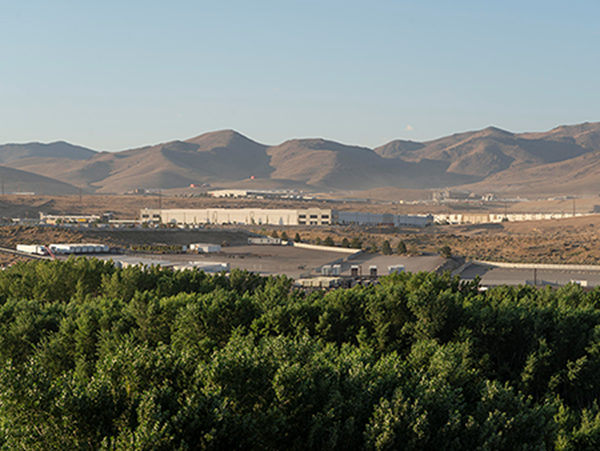
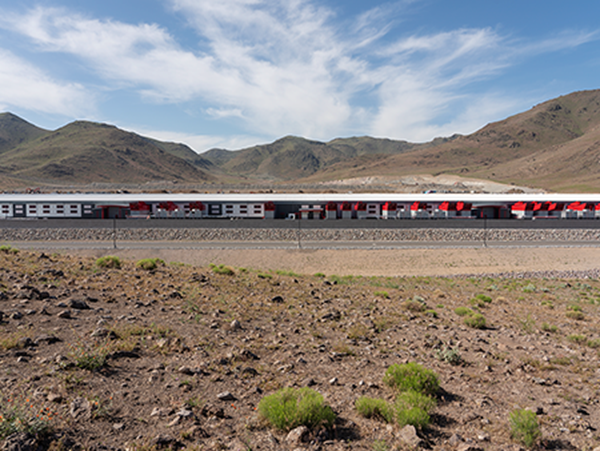
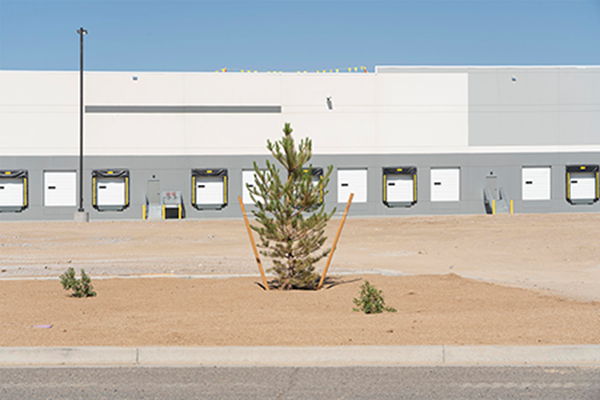
Scott Hinton
Expendition
Photo Acrylic Prints
Expendition is a landscape photography exhibit and a presentation of ongoing cultural geographic research at Tahoe-Reno Industrial Center (TRIC) in rural Storey County, Nevada. This interdisciplinary collaboration between geography and photography highlights findings of a complex political economy during multiyear fieldwork in Northern Nevada. The images and narratives acknowledge the past, examine sustainability in the present, and advocate for a more informed future.
Scott Hinton received his BFA from the University of Nevada, Reno and his MFA from San Jose State University. He is a photographer and educator at the University of Nevada, Reno documenting the complex geographies of the human environment in landscapes of the evolving American West. The stimulus to photograph in the West is to experience the grandeur of open spaces and the expansive mountains and deserts. Simultaneously these lands are critical to the health of many ecosystems and are under constant threat from an evolving climate and urbanization. Scott Hinton has been working on projects that activate collaboration with other artists and scholars. Convergence Zone investigates wildland fires of the western US. Grounded in the proximity of geography the expansive portfolio documenting the growth of the Tahoe Reno Industrial Center has been a collaboration with geographers and anthropologists to explore the intersection of warehousing, product distribution and governance of land use. These projects tie back to a reoccurring theme of the human wild interface and continuing a dialog of landscapes in flux.
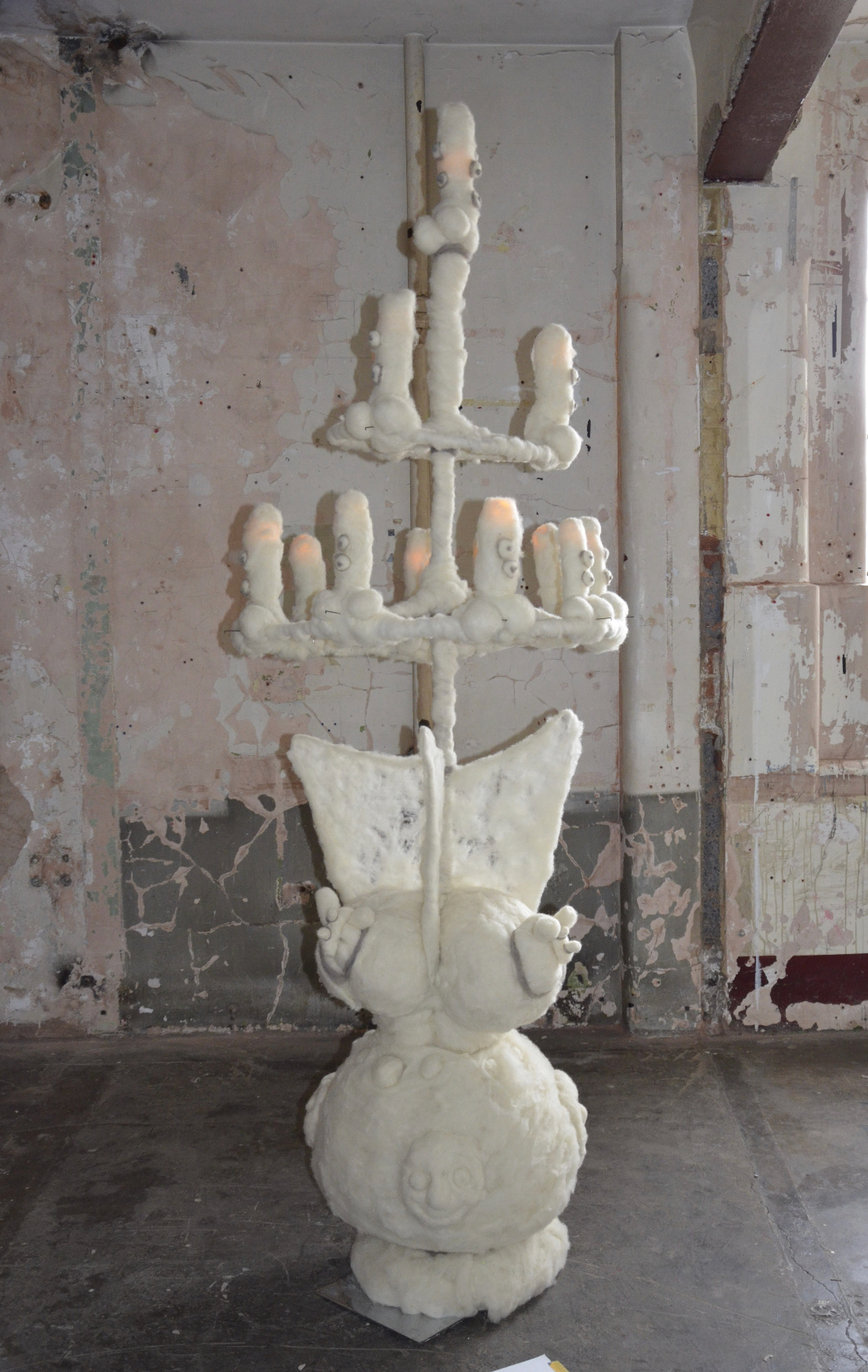
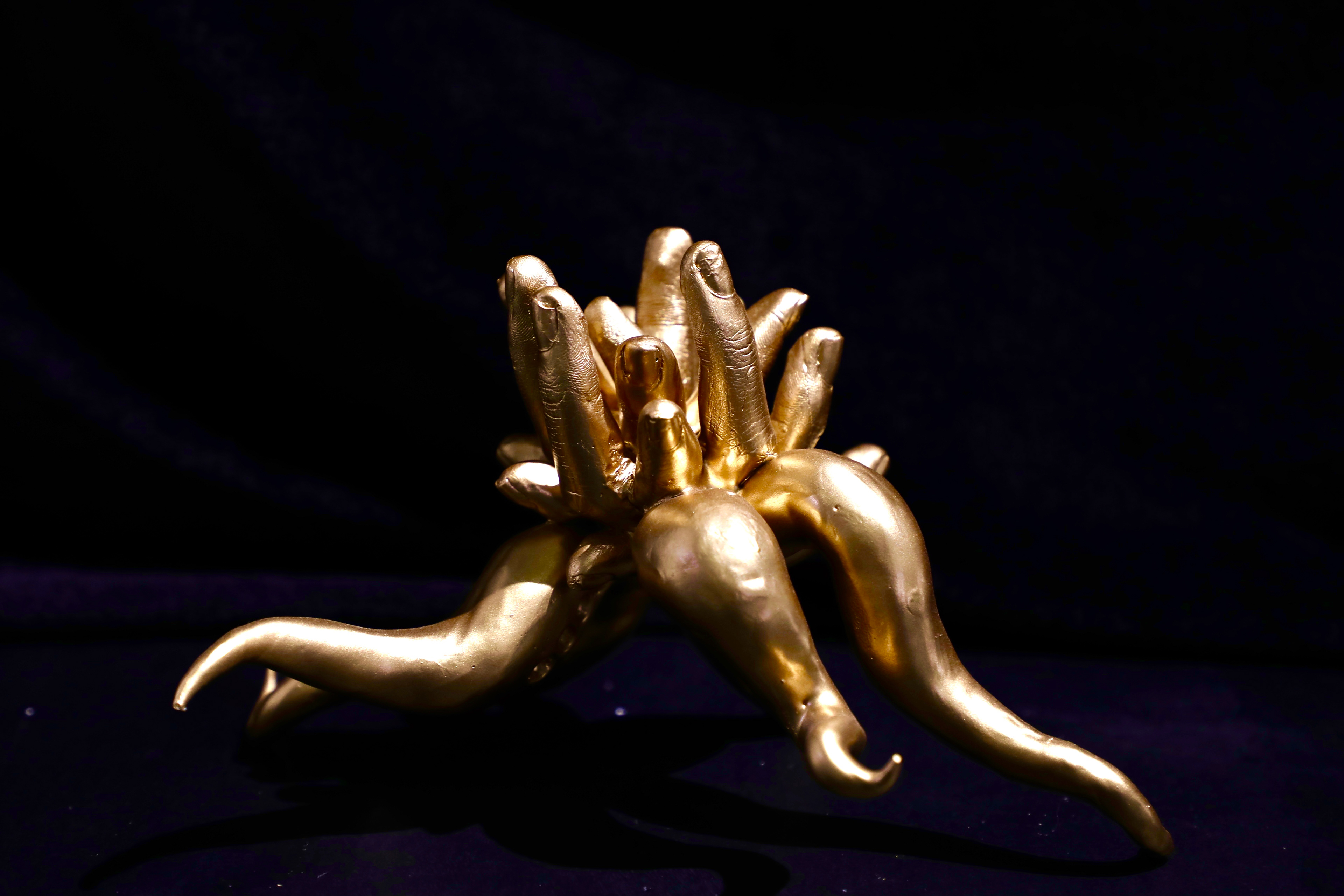
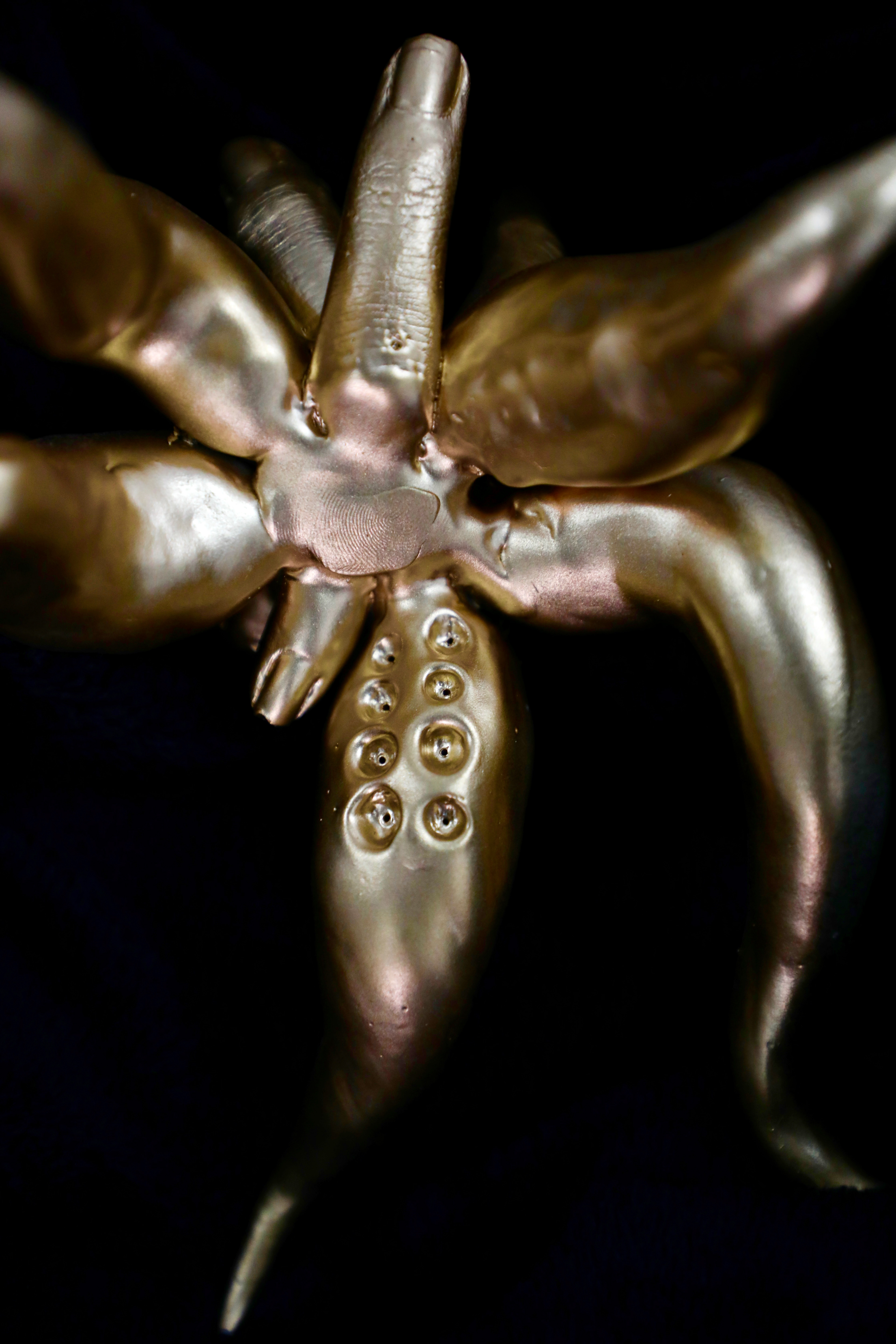
Sirui Lao
Totem1; Totem2
Wax Sculpture, Spray paint; Wool, Steel Bracket, Candle; 3D Printing, Copper Casting
In Totem1, I deconstruct the symbols and spiritual mediums of mainstream religions such as Buddhism and Christianity, creating a shell religion. This religion believes that humans live primarily driven by bodily instincts, awaiting spirits that are interested in inhabiting the idol. Totem1 is the idol I created for this shell religion, serving as the connection point between humans and unknown spirits, a space for spiritual communication. In Totem2, I realized that human beings' innate talent is 'animalistic.' Fear is the root of humanity. It dominates humans and drives their development. In this chaotic frenzy, I extracted humanity’s greatest fear and created a candlestick for the shell religion’s church— Totem2: Fear Response.
I am an artist who always follow sensation, make mix media sculpture and performance. I reflecting on themes of karma and Metta, search for purity and equanimous without actual religious. I usually around the subject like ceramics or dreams, love or sin, medication or meditation and feather, pearls or metals —— seeking to hidden tensions and collective unconscious happiness. My art aims to transcend symbolism, blending beauty with complexity, and inviting reflection on the obscure balance between the spiritual and physical realms.
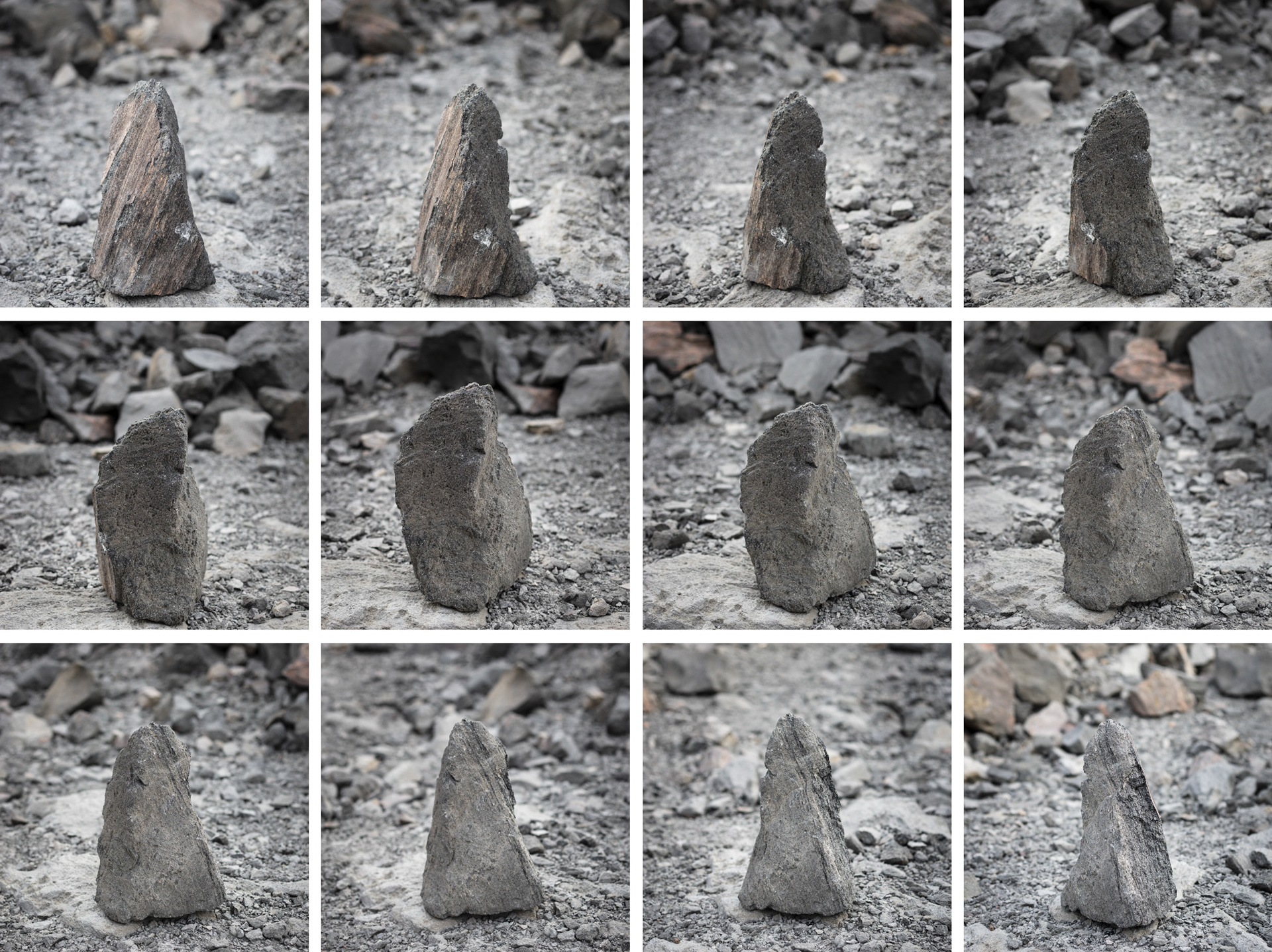
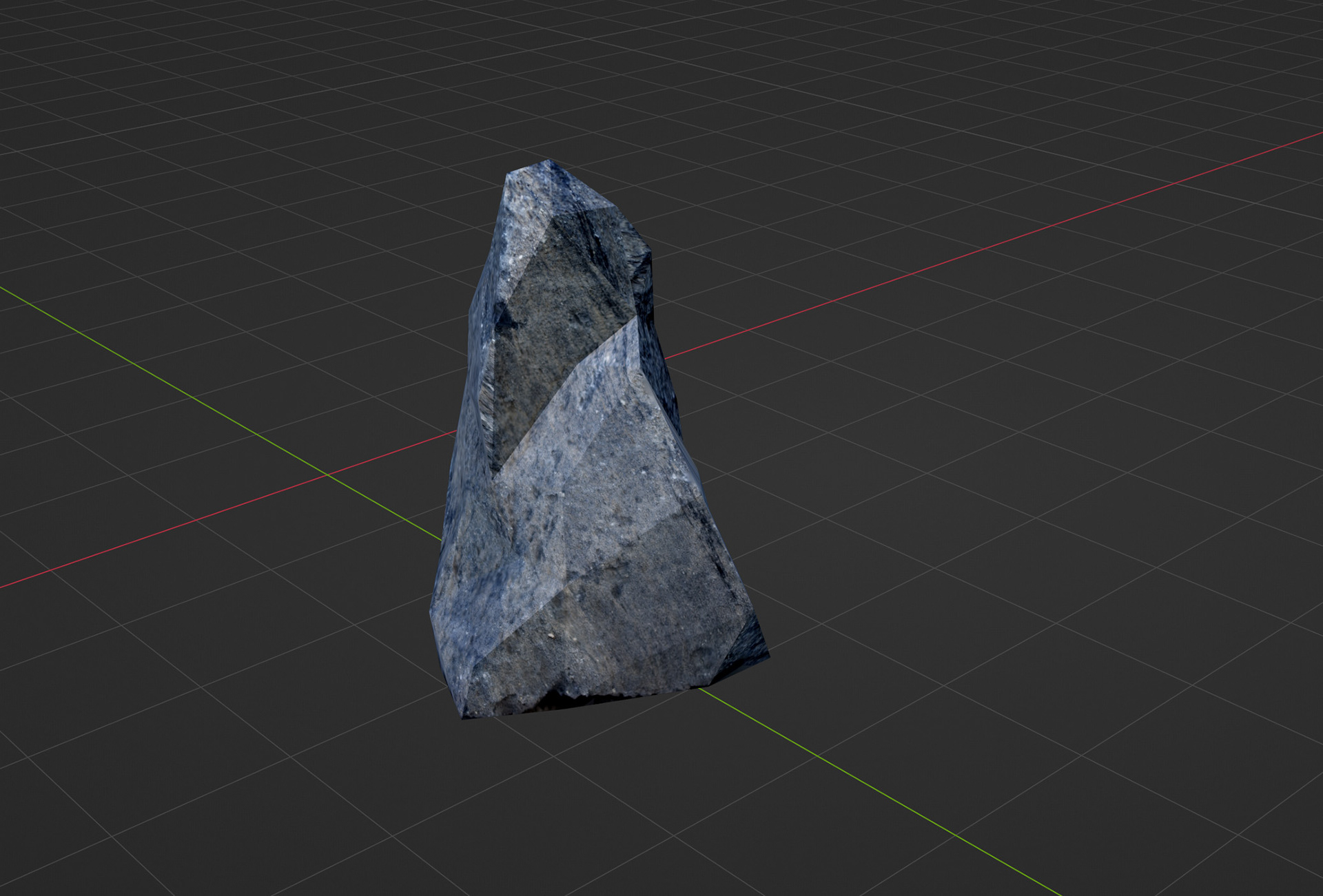

Bobby Lee
Monolith; Replica
Pigment Prints, Metal Wire; Pigment prints, Matboard, Digital Model
In Monolith, a photograph of a rock monolith in the High Rock Canyon area of the Black Rock Desert is displayed with a physical sculpture of the monolith made from a crumpled photographic print. Similarly, Replica shows a grid of photographs taken around a 3-dimensional rock displayed along with a physical polygonal representation of the rock. These works reflect on the photographic representation of an object and its relationship to simulation and reality. These objects exist in the world and are visualized in space of the gallery.
Bobby Lee is a landscape photographer and book artist whose work focuses on the natural world and sense of geologic time revealed in exposed rock layers and other landforms. Rooted in a sense-based experience of encountering and exploring landscapes, his photographic work incorporates multiple image arrangements and the creation of photo-book-objects to allow for a deeper examination of ideas around human relationships to land.
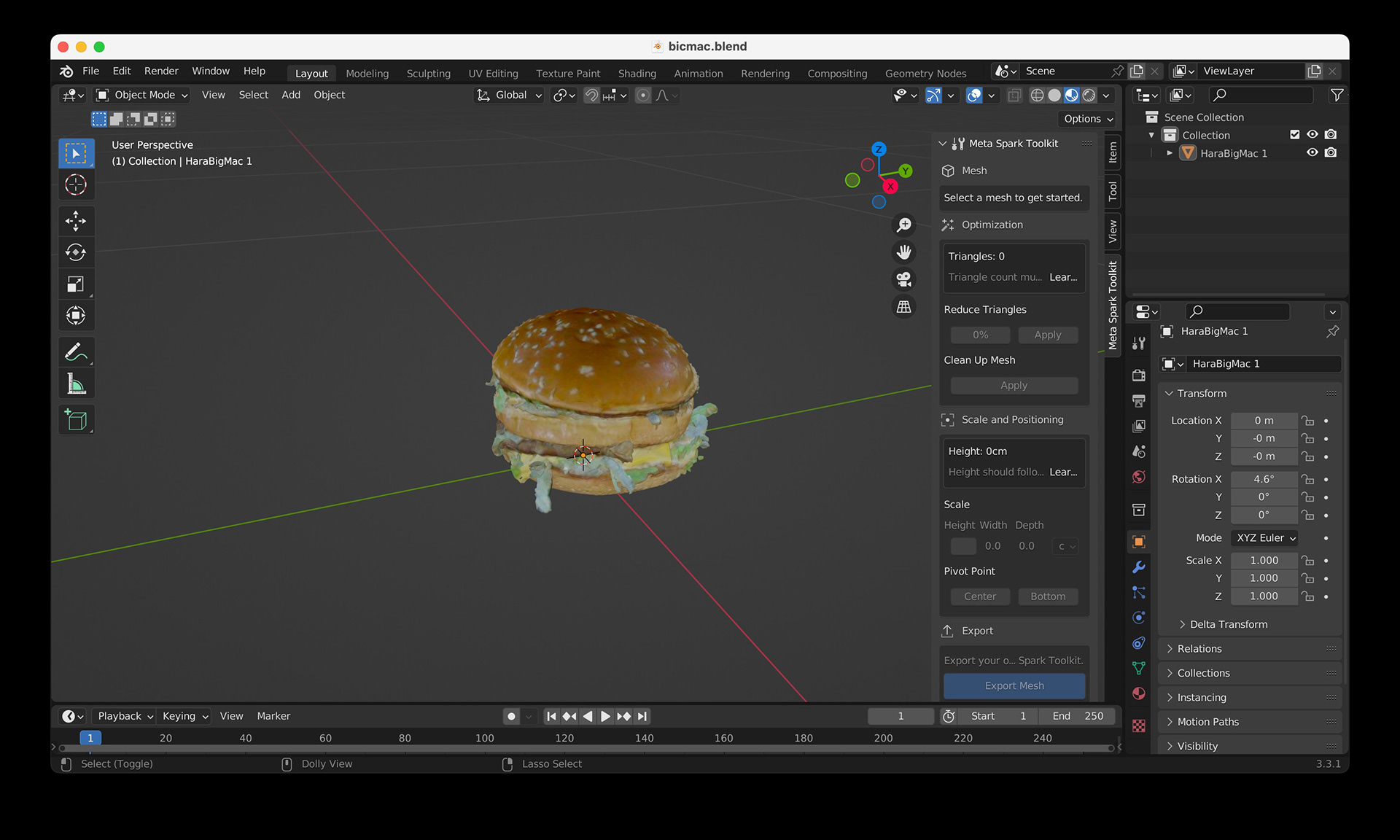

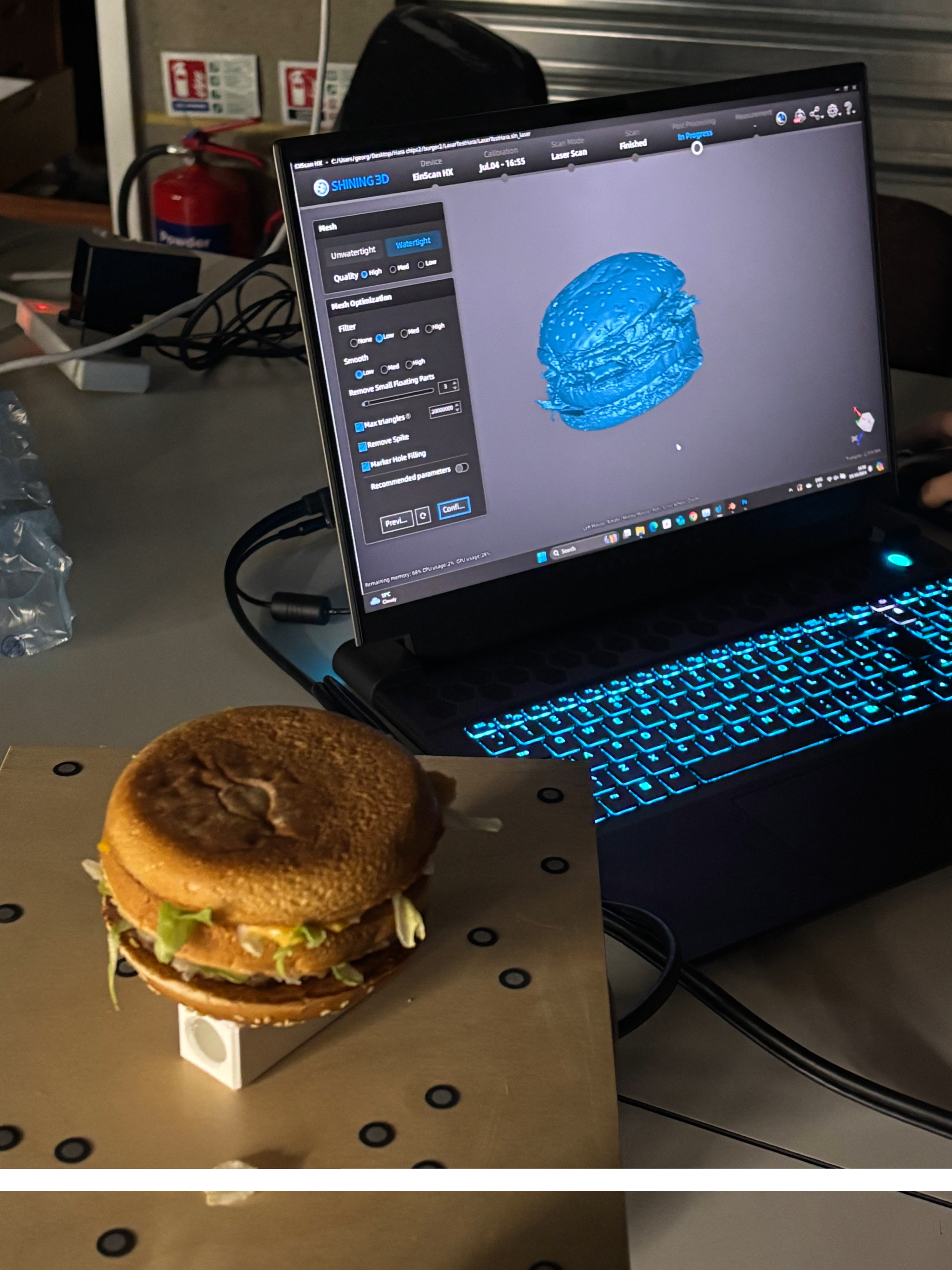
Hara Lee
Doughnuts; Untitled; Untitled; Untitled
Video with original sound, 2:57; 3D Print; Print on Paper; Video without sound
The subject ‘In Real Life’ could be described by her artistic practice ‘How the online experience is applied to reality’. She is exploring the potential commerciality and consumerism that social media and video platforms have. And it studies the behaviour patterns of people who consume contemporary culture and the 'nonexisting-existent' that is implicit in its, paradoxical illusions, and futility. Through this project, she wants to discuss in-depth how the phenomenon of hot trends in the online world, which is constantly reproduced, is applied and discovered in real life.
Hara Lee, born in Seoul, is currently pursuing her bachelor's degree at UAL Camberwell College of Arts in London. She primarily works with found-object sculptures, combining video and photography to explore societal phenomena. By connecting everyday objects with universal and personal emotions, her practice reflects modern life experiences within capitalism. Her current project adopts a pessimistic lens on contemporary culture, creating sculptural works based on digital trend data. She examines how the phenomenon of endlessly reproduced online trends manifests and is discovered in real-world contexts.

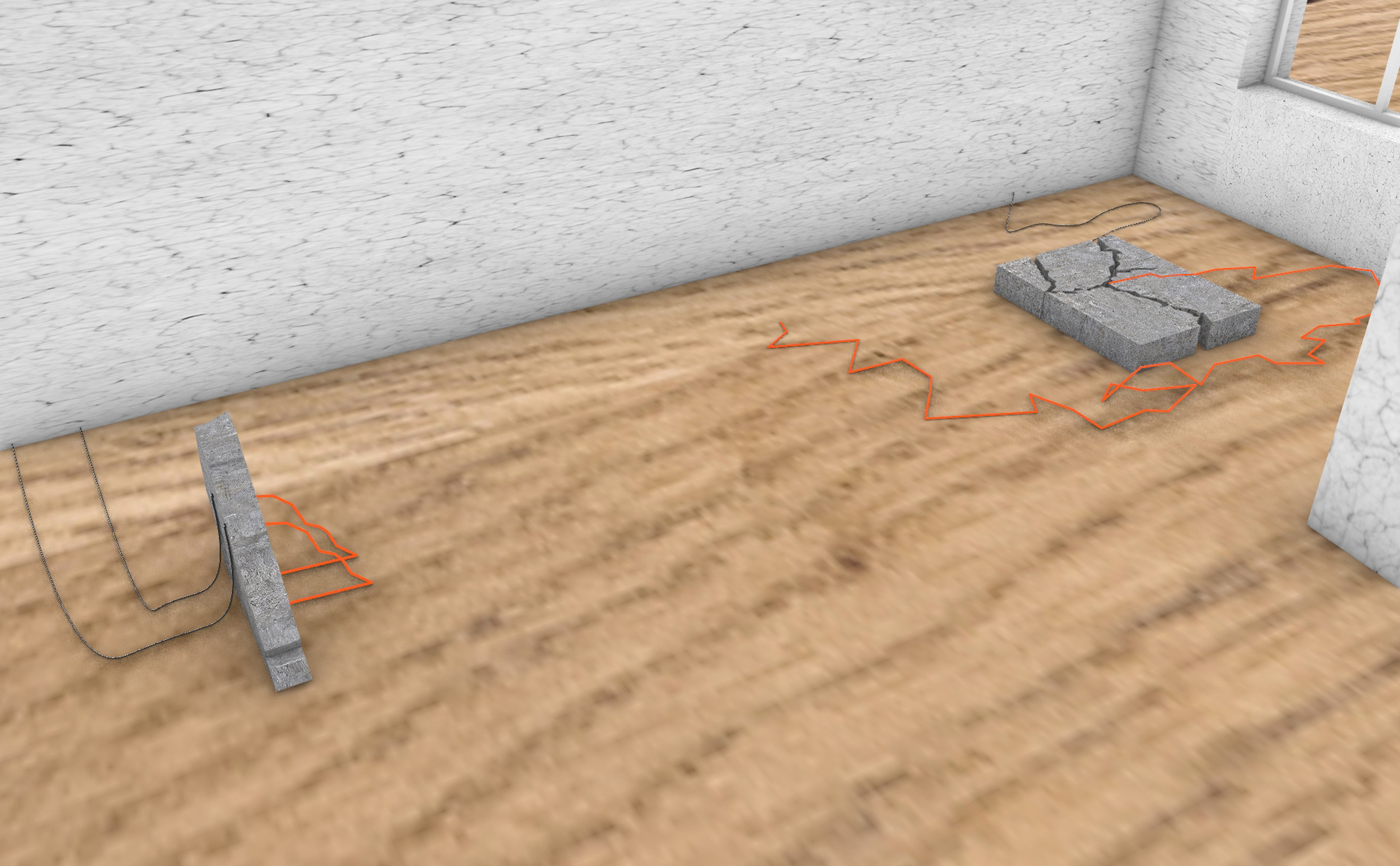
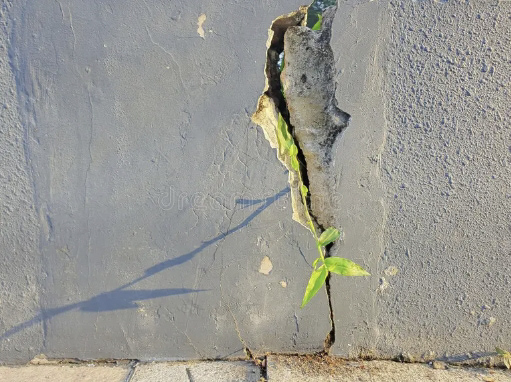
Karl Xinghao Liang
Static1; Static2
Concrete, Led light, Cable
These installations, dominated by two industrial materials—concrete and neon tubes—examines the intricate relationship between support and growth, fragility and reinforcement. In the work, the tubes embody a "dual identity," appearing both to support the concrete structure and to emerge from its cracks as an organic force. (The context of Reno imbues the work with unique cultural significance, it known for its distinctive history, industrial foundation, and industries, yet it has also undergone economic transformation and regeneration over time, neon evokes associations with Reno’s iconic neon signage and its vibrant social scenes.)
Born in 1999 in Beihai, China, Karl Xinghao Liang is a London based artist. He studied at the China Academy of Art and earned his MA from Chelsea College of Art, where he was awarded Geoff Dudley Fellowship. Karl Xinghao Liang is a multi-media artist whose early practice focused on painting and sculpture. In recent years, his work has expanded to explore the intricate relationships between installation, sound, space, and action. Central to his approach is the concept of “art in progress,” emphasizing art as a dynamic, evolving process rather than a static end result. Through an in-depth exploration of space and sound, he aims to craft immersive environments that invite intuitive perception and direct audience participation, transforming art into an immediate and interactive dialogue.
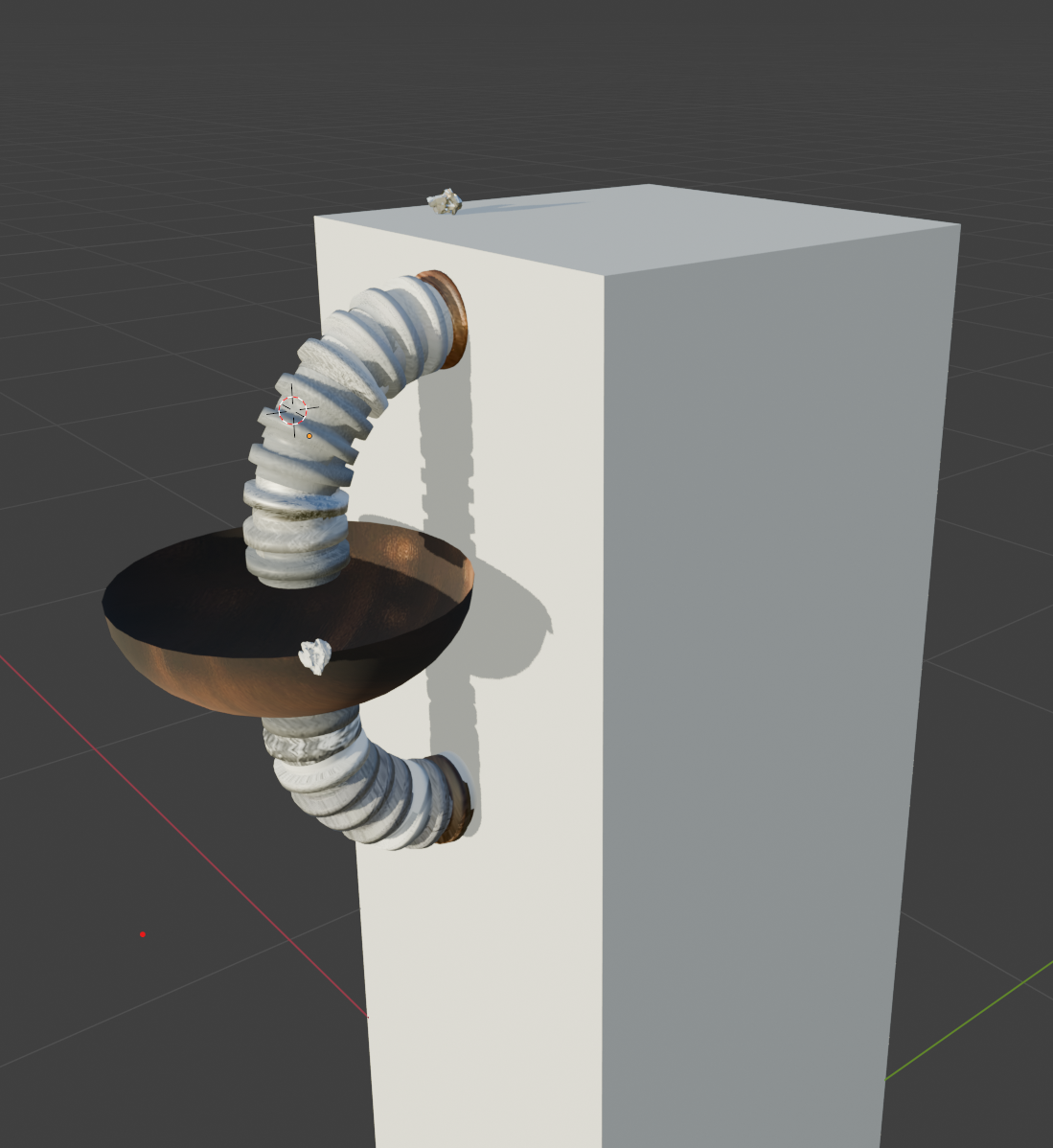

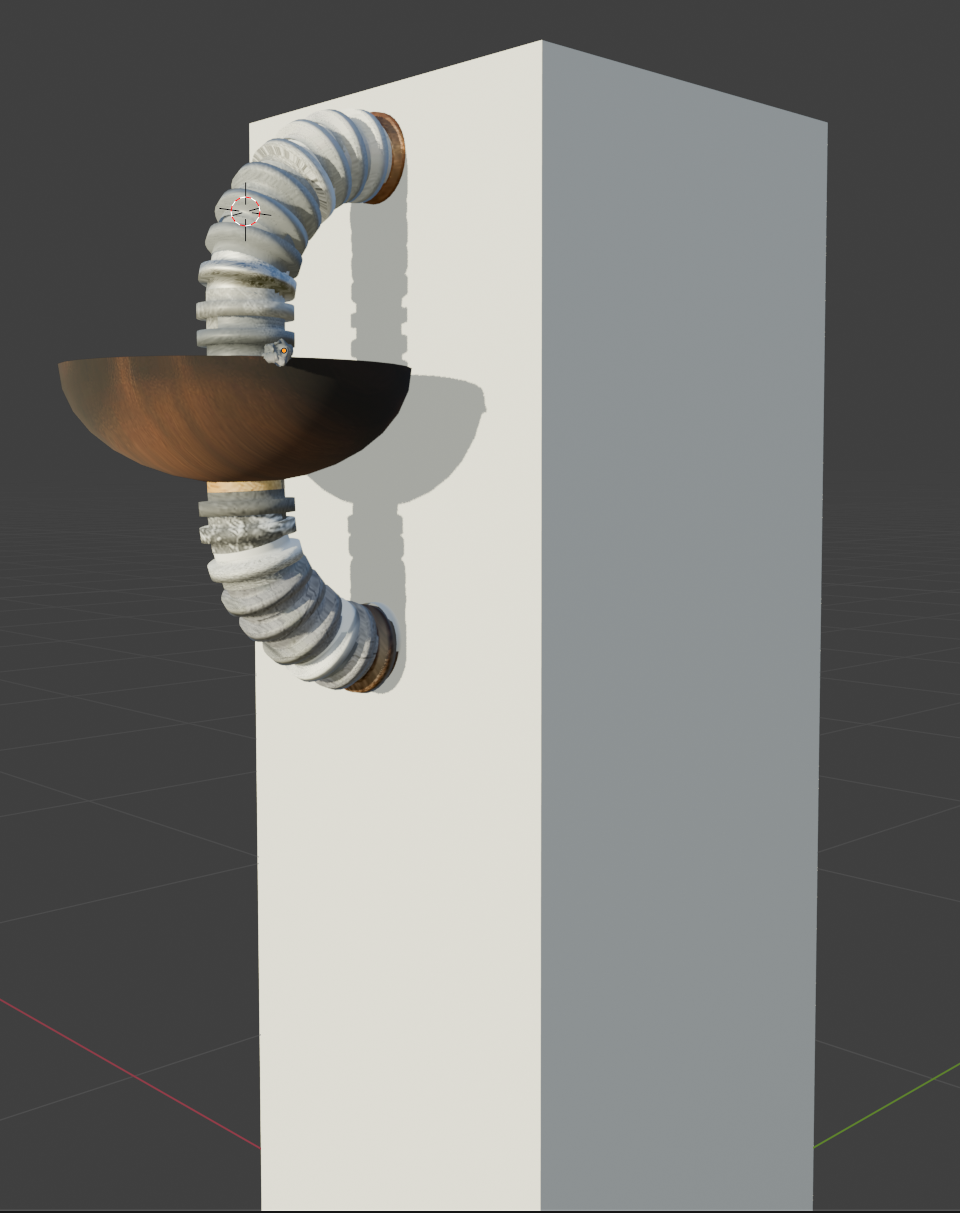
Mengmeng Luo
Recursion
Installation
The work Recursion is a project centered around a circulating water pipe, inspired by my research into the history of gold mining in the Reno area. This project explores the cyclical nature of the mining process, where water is constantly reused in a loop, much like the repetitive cycles of extraction and consumption throughout history. By using the metaphor of water circulation, the work reflects the ongoing, recursive relationship between human activity, natural resources, and the environment. The water pipe becomes a symbol of both the literal and metaphorical cycles that continue to shape the region’s history and its present.
Luo Mengmeng (Momo), a Chinese visual artist born in 1999, is based in London. A graduate of Chelsea College of Art and Design, her work combines film, sculpture, and architecture to create surreal, time-bending narratives. Formerly a journalist and film director, Momo explores media's influence on societal beliefs and collective memory. Her film Glitch in the Matrix won an award at the 2022 Athens International Film and Arts Festival and was exhibited at the 2023 Rea Art Fair in Milan. In 2024, she participated in a residency at Xu Liaoyuan MOMA in Chengdu, China, and published her first book, Immobile Deterritorialisation, with Snap Collective.
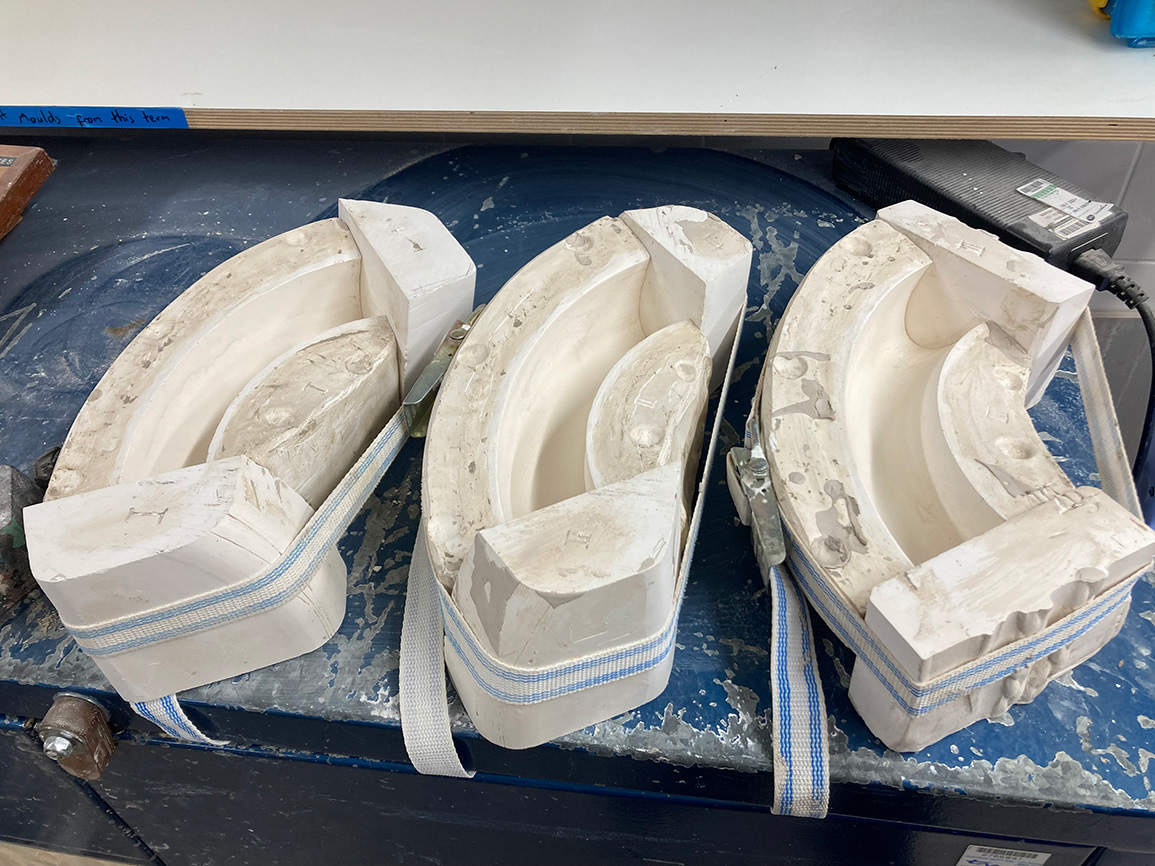
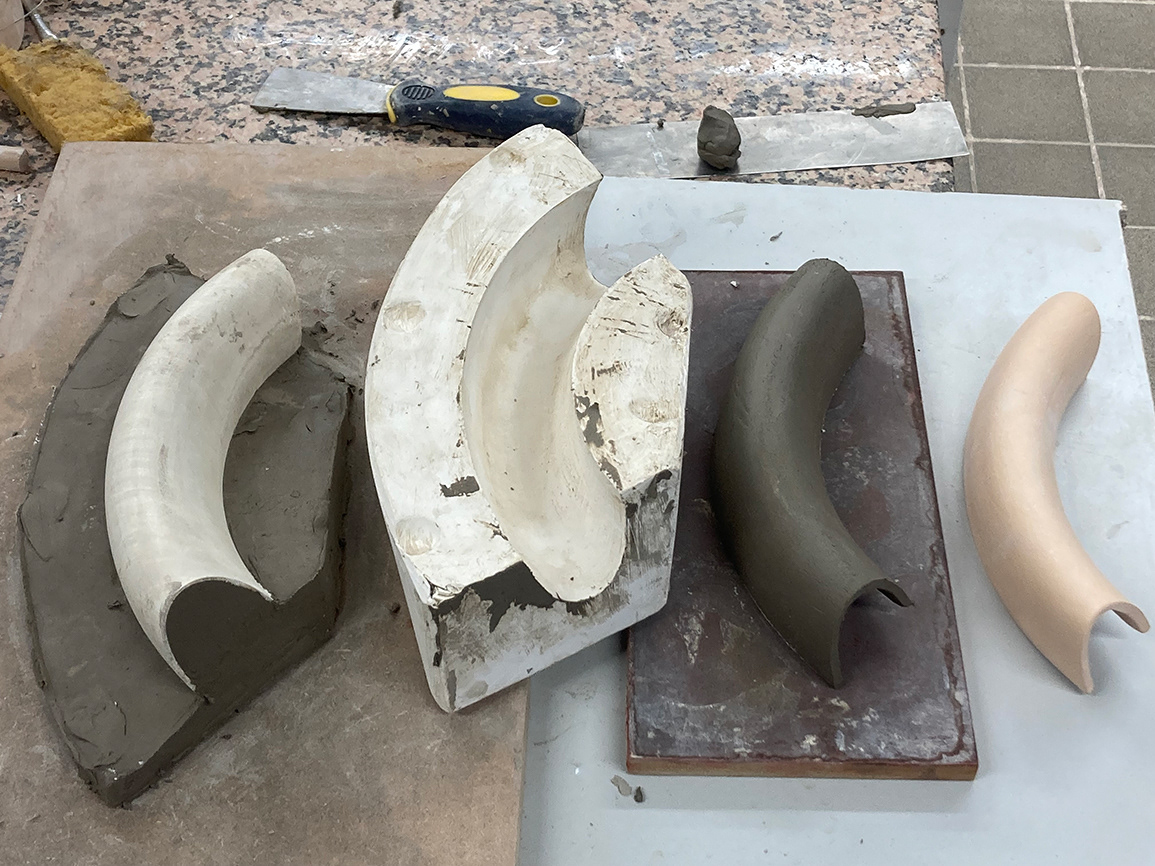

Taslim Martin
Helix Modular
PLA plaster and ceramic
This work is the revisiting of a previous work created in 2010 for an exhibition at Touchstone Gallery in Rochdale. This recent version was created using a range of processes including 3D modelling, digital fabrication and mould making.
Martin worked as a carpenter and joinery for 13 years before attending art school both in Cardiff and the Royal College of Art in London, awarded the Sir Eduardo Paolozzi Travel Scholarship that facilitated research into West African sculpture. Two years as Artist in residence at South Hill Park Arts Centre, Berkshire culminated in a solo exhibition in 2000. Awarded first public art commission, since then he has been engaged in gallery exhibitions, public art commissions and teaching. His creative output ranges from portrait sculpture to public art and design. He has exhibited in the UK and internationally and his works are in the permanent collection of the British Museum and the Horniman Museum. Taslim Martin lives and works in London.
Nina Ołtarzewska
Give me my bones back!
3D Print PLA
Give me my bones back! is formed of three abstract sculptural objects. It visualises the decay of major organs [gut, heart, brain] stripped from their supporting surroundings [bones/flesh/skin]. Give me my bones back! is an inquisition into the strength and reliability of information without its context.
Nina Ołtarzewska (b.1998) is a French artist based in London. She briefly attended the Panthéon Sorbonne’s Fine Art course before moving to Northern Ireland where she graduated with a BFA in 2021 from the Belfast School of Art. She received five graduate awards from art institutions upon graduating. After being chosen for Flax Arts Emerging Artist programme and practicing in Belfast for a year, she moved to London to pursue an MA Fine Art at the Chelsea College of Art. She received the Sir Frank Bowling Scholarship and graduated with distinction in 2024. As well as practicing individually in London, she is one fifth of SUCCESSFUL ARTISTS collective.

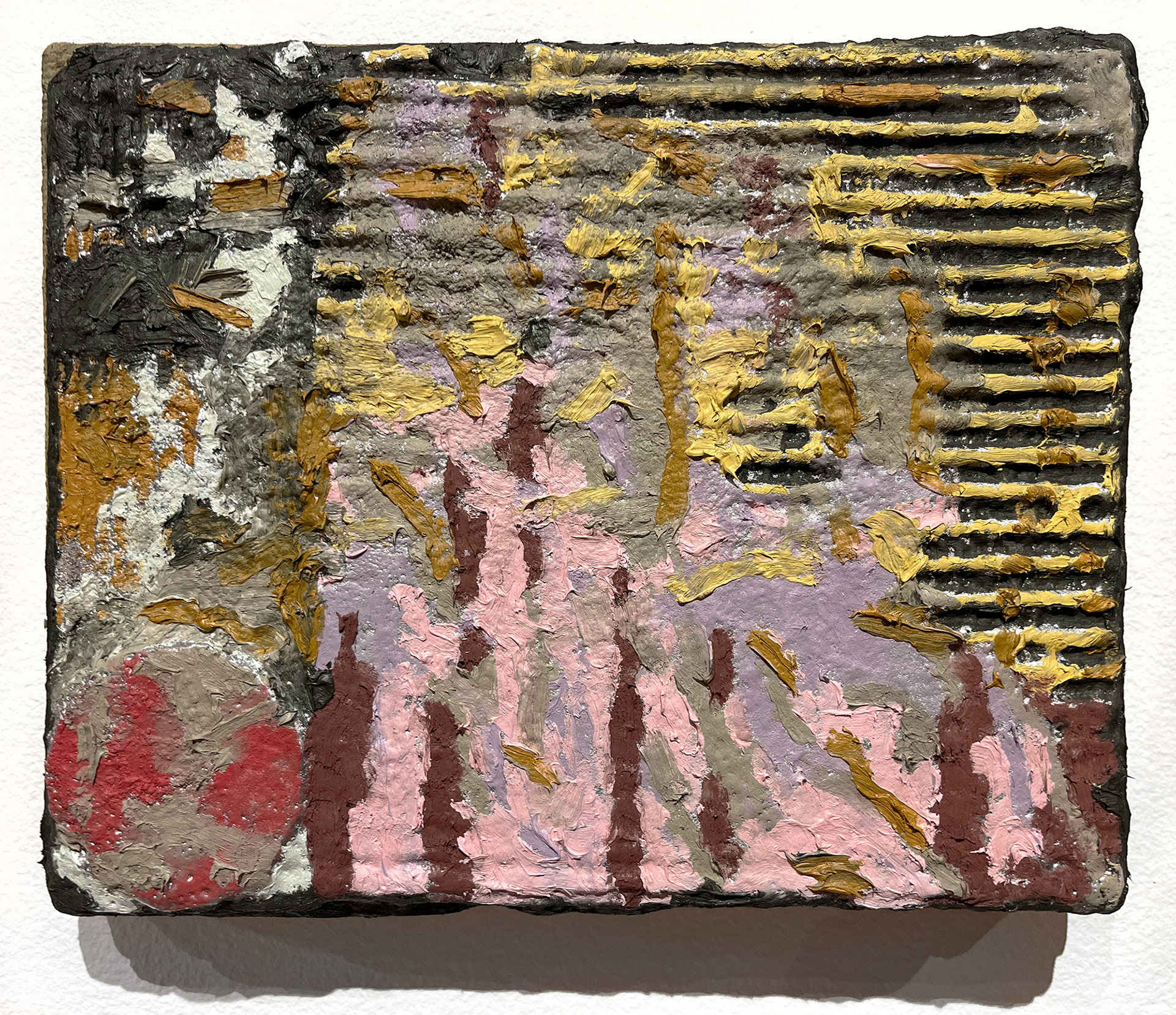
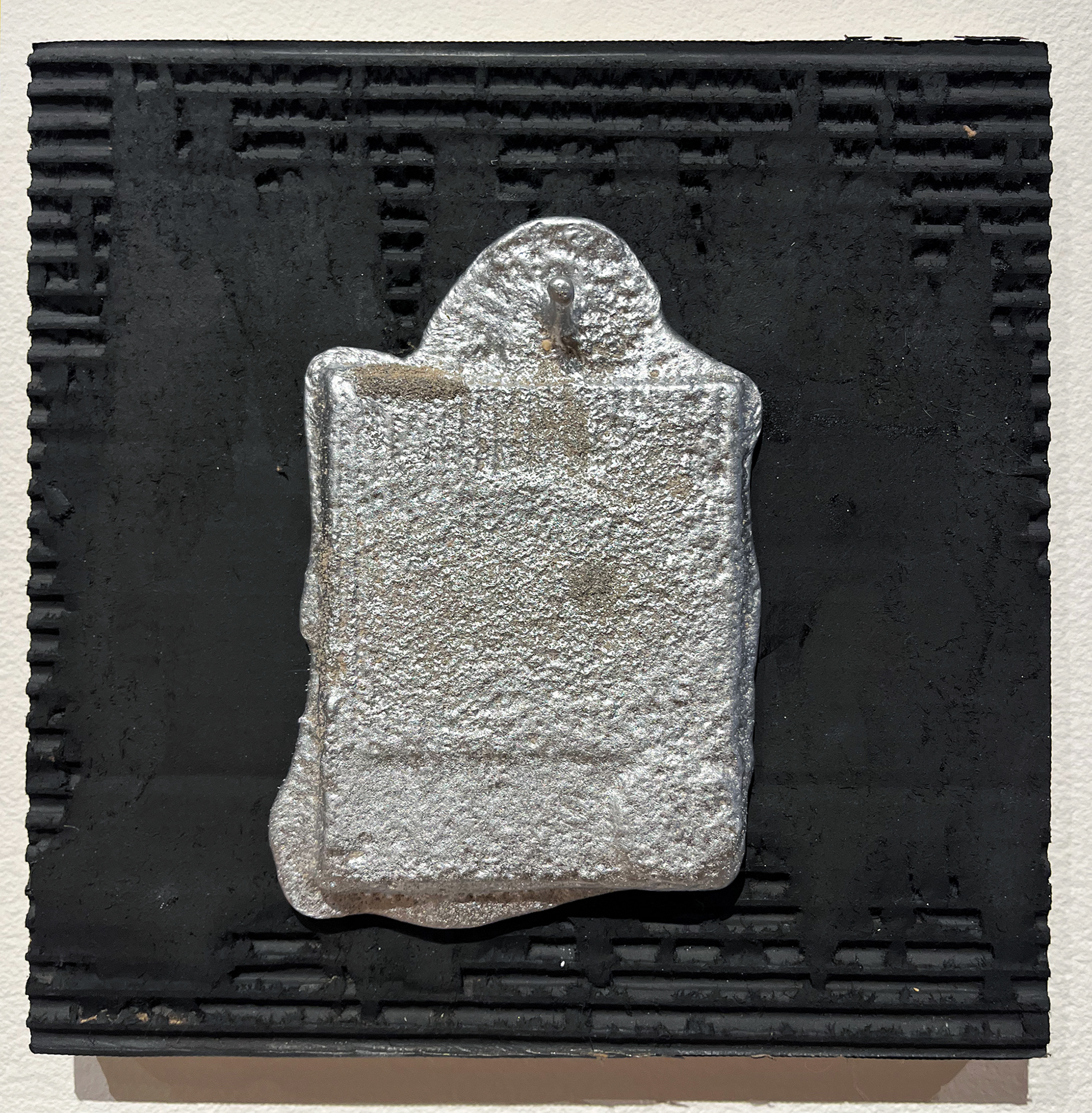
Austin Pratt
No Resolution
Oil on Cast Aluminum with Cardboard on Panel; Oil on Cast Aluminum on Burlap over Panel; Oil on Cast Aluminum with Cardboard on Panel
These paintings follow questions about legibility and translation across generational processes. Beginning with a sculptural collage, then sending it through various digital and analog molds, I was curious about eventually creating an index of this lost original form and using it as low-relief painting surface, noting what is preserved or lost, and where meaning might arise.
Austin Pratt is an artist and educator based in Reno, Nevada. He received an MFA in Painting+Drawing at The University of Tennessee. Through a primary studio practice of painting and drawing, Pratt's work consists of reprocessing fragmented images, textures, and patterns from wide sources in visual and material culture as a means to test and connect disparate ideas and interests from pattern recognition and perception psychology, to phenomenology, cultural geography, and ecology. Using a formal language of painterly organic abstraction, materiality, and idiosyncratic mark-making, the work vibrates between real physical object and illusory image, often grainy, dry, and caustic in affect. The work continues to test it’s own edges, often extending out of ‘the rectangle’ and into shaped paintings, wall-hanging ceramic “paintings”, collaborative drawing, and non-narrative video work.
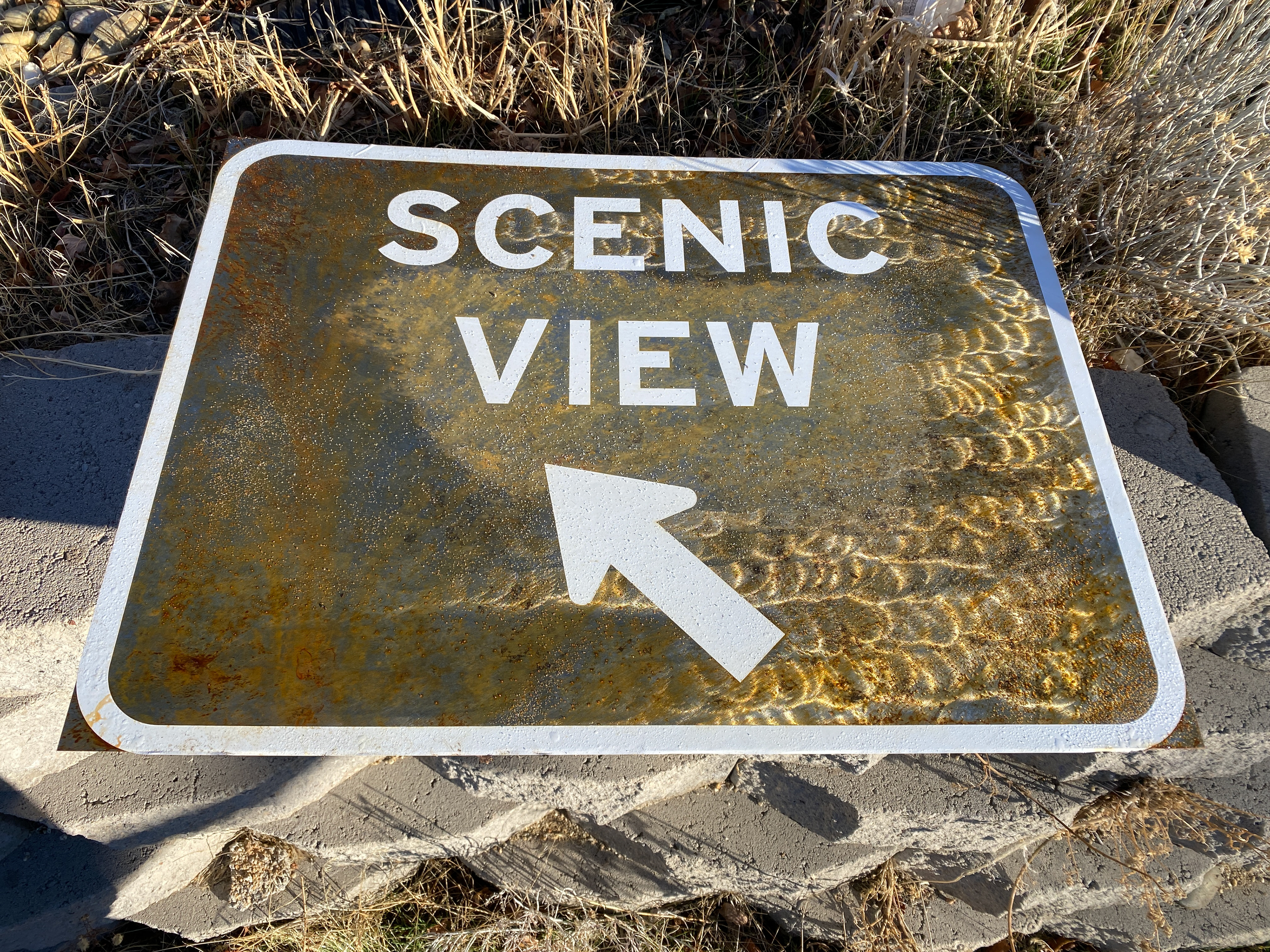


Luke Rizzotto
Signs of Control
Rusted Steel
Thinking about the concept of a “control city” — a city used on highway signs to display remaining miles to important cities — as well as Deleuze’s concept of “the Society of Control”, these works consider the function of road signs within day-to-day life and the control they exert. Specifically, these works ponder the subliminal force exerted by road signs as they direct us towards or away from specific places and ideas. While certainly not all such road signs are insidious — and often are necessary — it is still worth considering how we allow our lives to be shaped by signs designed by forces with specific intentions.
Luke Rizzotto is a digital media artist, musician, designer, and educator whose work examines memory, nostalgia, and yearning as it relates to place and travel through the creation of unreal landscapes and spaces. Originally from the New Orleans, Louisiana area, he currently resides and works in Reno, Nevada. He graduated in 2019 from the University of Louisiana at Lafayette with a BFA and in 2024 from the University of Nevada, Reno with an MFA. He has been recognized as a Resident Artist at Le Germinal in Newport, Québec in 2024 and with the Friends of Black Rock-High Rock and Bureau of Land Management in Gerlach, Nevada in 2023. He has recently exhibited at the Holland Project in Reno, Nevada, Solarpunk Surf Club in Lexington, Kentucky, New Media Contemporary in Dallas, Texas, Plexus Projects in Brooklyn, New York, and the Cookhouse Gallery at the Chelsea College of Arts in London, United Kingdom.
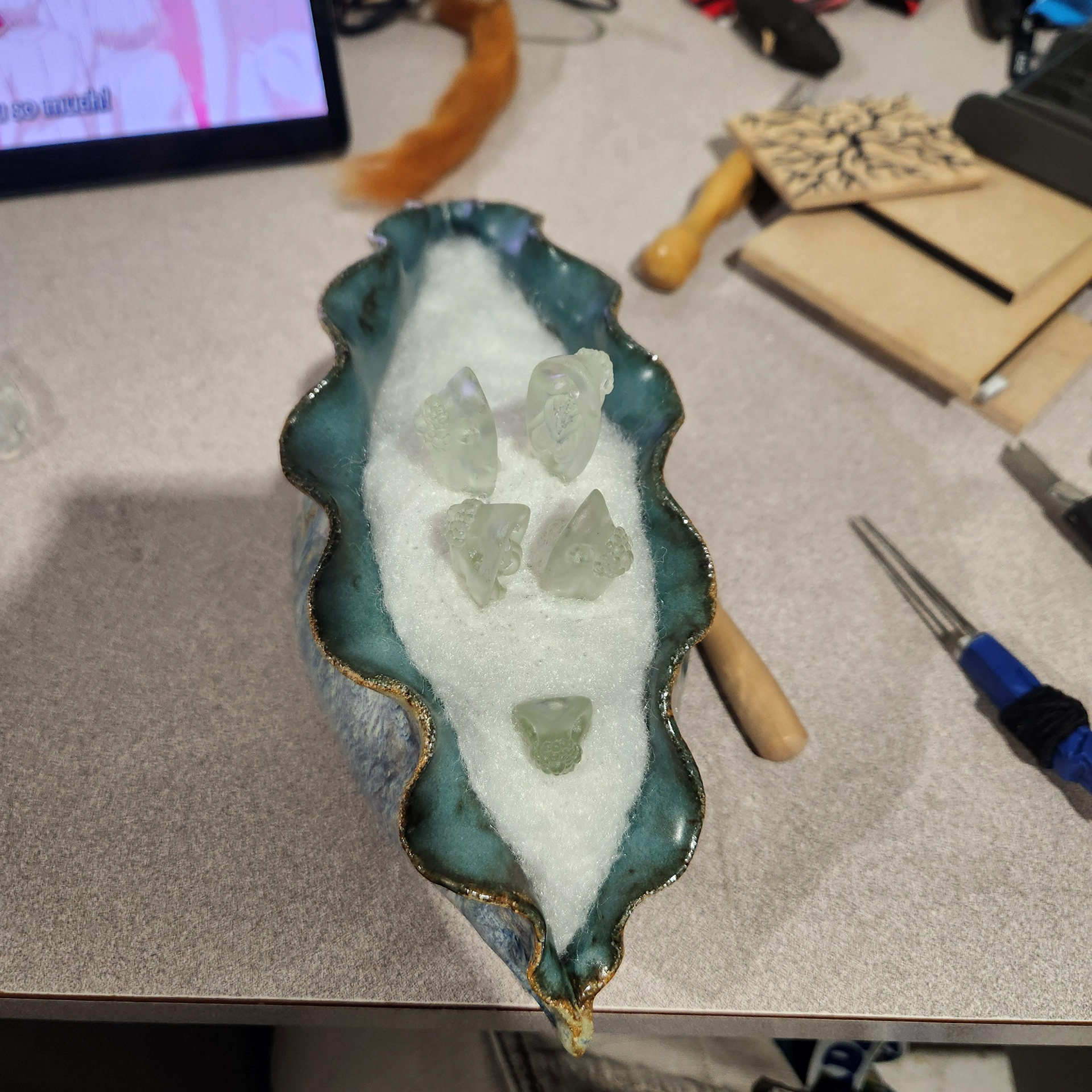
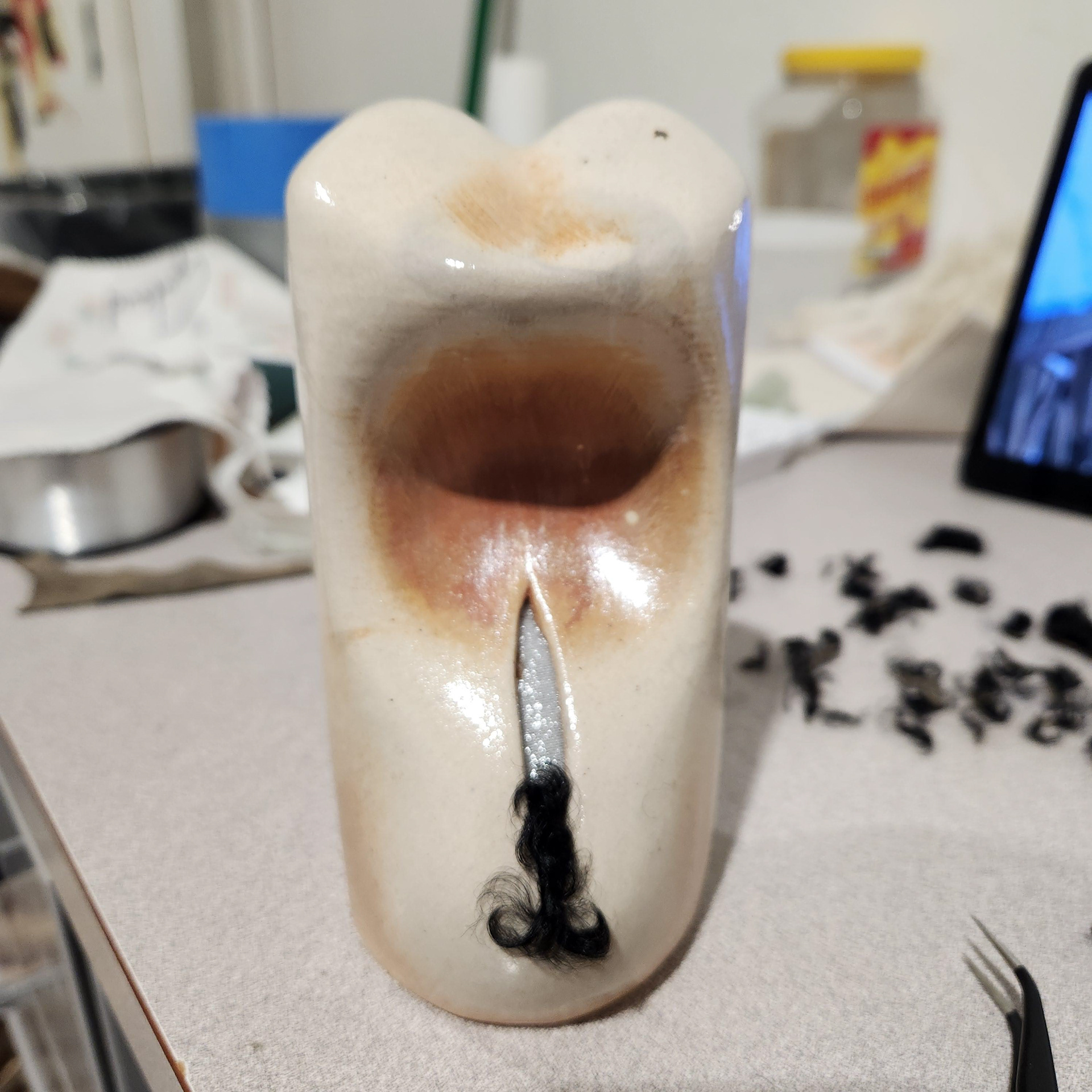
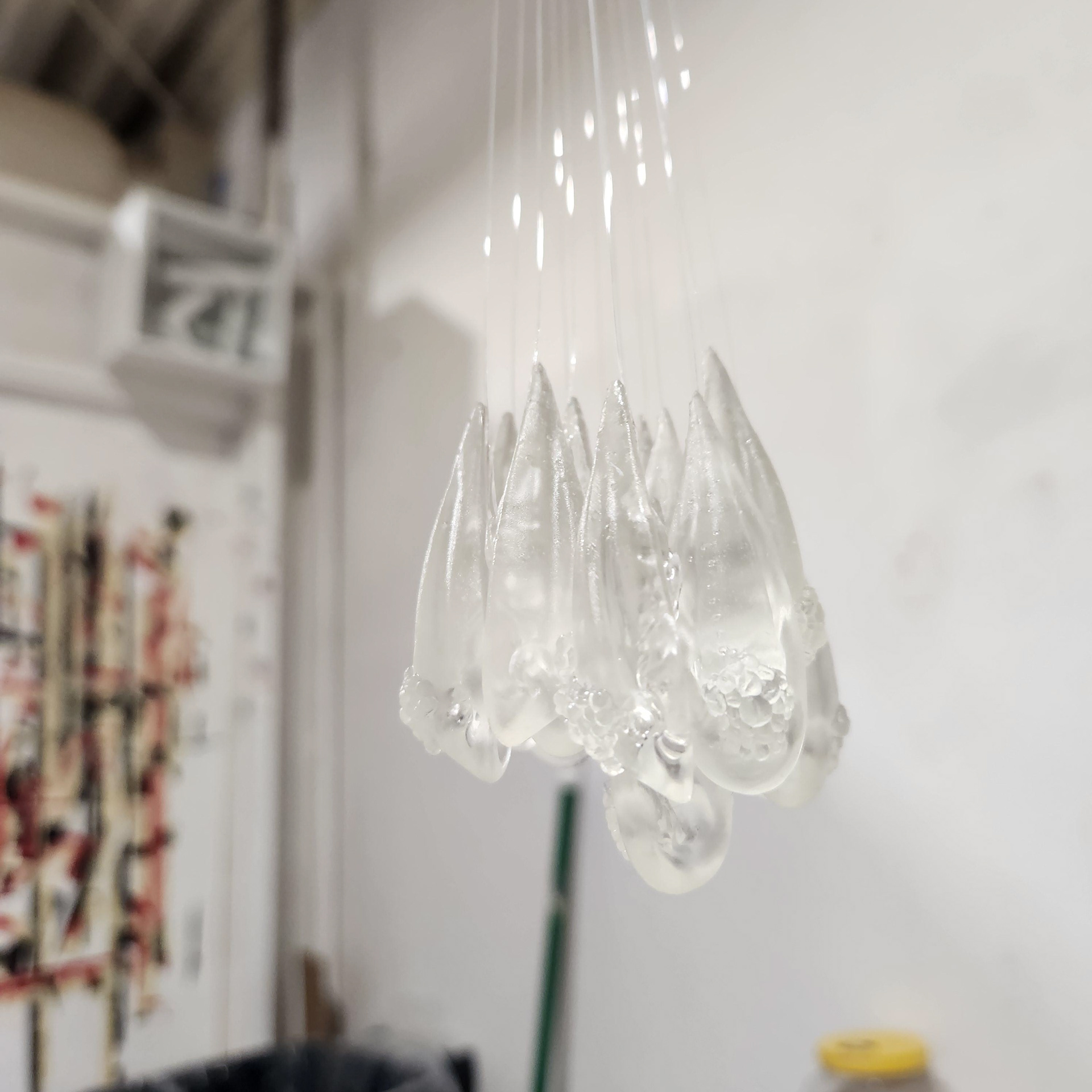
Adrian Rodriquez
Hatchlings; Happy Trail
Ceramic, Glaze, 3D-Printed Resin, Mixed Fibers, Fishing Line; Ceramic, Fetal Lamb Wool
Hatchlings - This is my interpretation of what an alien egg case of an other-worldly creature could look like. I took inspiration from Giant clams, for the shell of the egg case, along with inspiration from how praying mantises hatch from their egg cases. These inspirations are strange to me and not common in this world, and the strangeness of these creatures reminds me of things from science-fiction and fantasy media that I depended on for escape as a child, to get away from and forget about the loneliness from being bullied and not fitting in with the people around me. I wish to be in those fictional worlds rather than in the real world.
Happy Trail – Abstract form of the male body.
Adrian Rodriguez is a Nevada-born artist who is fascinated by Sci-Fi and Fantasy worlds, as well as the natural world. He works with a variety of media including plastic, ceramics, wood, and many different kinds of fibers, using these materials to create his interpretations of alien life. Separately, he explores the male body and his sexuality through abstract human forms. He is currently a BFA candidate at the University of Nevada, Reno.
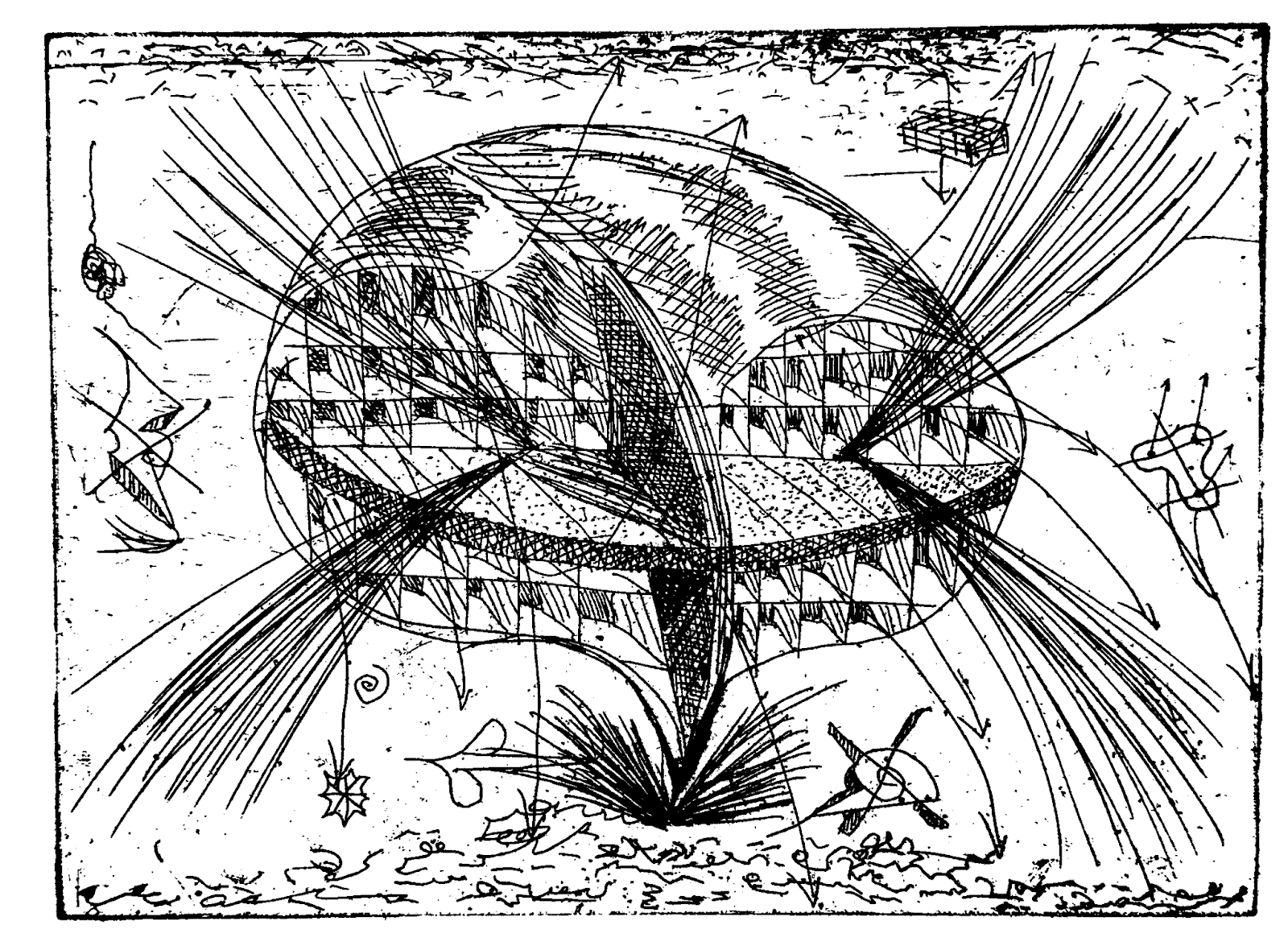
Sean Steadman
Head
Laser-Cut Woodblock Print on Japanese Paper
A woodblock print made by taking an etching by the artist and scanning it, then using the digital file to laser engrave a wooden plywood panel that was then printed using traditional woodblock print techniques.
British artist Sean Steadman was born in Chelmsford, England, in 1989. Sean is first and foremost a painter also working in printmaking and drawing. His painting is invested in the medium’s specificities and its ability to draw out new visual forms. His process is essentially intuitive and dialectical: after an initial drawing phase, Steadman works on the entirety of the canvas’ surface, applying, erasing, layering until a suitable starting point is achieved. This initial phase is deliberately fast and decisive, so as not to allow critical reflection. The actual making of the image occurs through what Steadman refers to as the “digging down, where the painting is as much uncovered as it is built up from the outside”.
Sara Sternberg
Welcome, please notice the area is under survaillence
Aluminium cast, pre-recorded sound piece
This project targets the manipulation of space by private entities to control and monitor how we utilize it. Specifically, metal studs placed on ledges to obstruct skateboarding, and pre-recorded sounds triggered by motion sensors to make it impossible to relax in a certain areas. The project questions the fetishization of relentlessly securitized infrastructures and what these represent in contemporary society.
Sara Sternberg is a multidisciplinary artist whose practice spans fine art, performance, sound, and video. She received a scholarship to pursue a Master's in Fine Art at Chelsea College of Arts, where she graduated with Distinction. Her work, Camarada D'aluminio, was featured at the London Design Festival, acquiring critical acclaim and coverage from platforms such as Dezeen and Designo Jornal. Collaboration is a key aspect of her practice, as exemplified by the partnership with artist Joseph Smith. Together, they created a performance project named There Must Have Been An Angel By My Side that toured four venues in London (2024) and was featured in a film directed by Maite D'Orbe. This project integrated sound and movement, performed by Lewis Waker for Lolo & Sosaku's sound piece, and later performed live by Sara for the premiere of Lolo & Sosaku’s short film in London. In 2024, she participated in the Sounding Bodies residency at Rua das Gaivotas, funded by DGART Portugal. This project will be toured across Portugal in 2025, further expanding their exploration of sound, intimacy and physicality. Besides this, she also wrote a fictional story featured in a zine published by Estrela Decadente earlier in 2024.
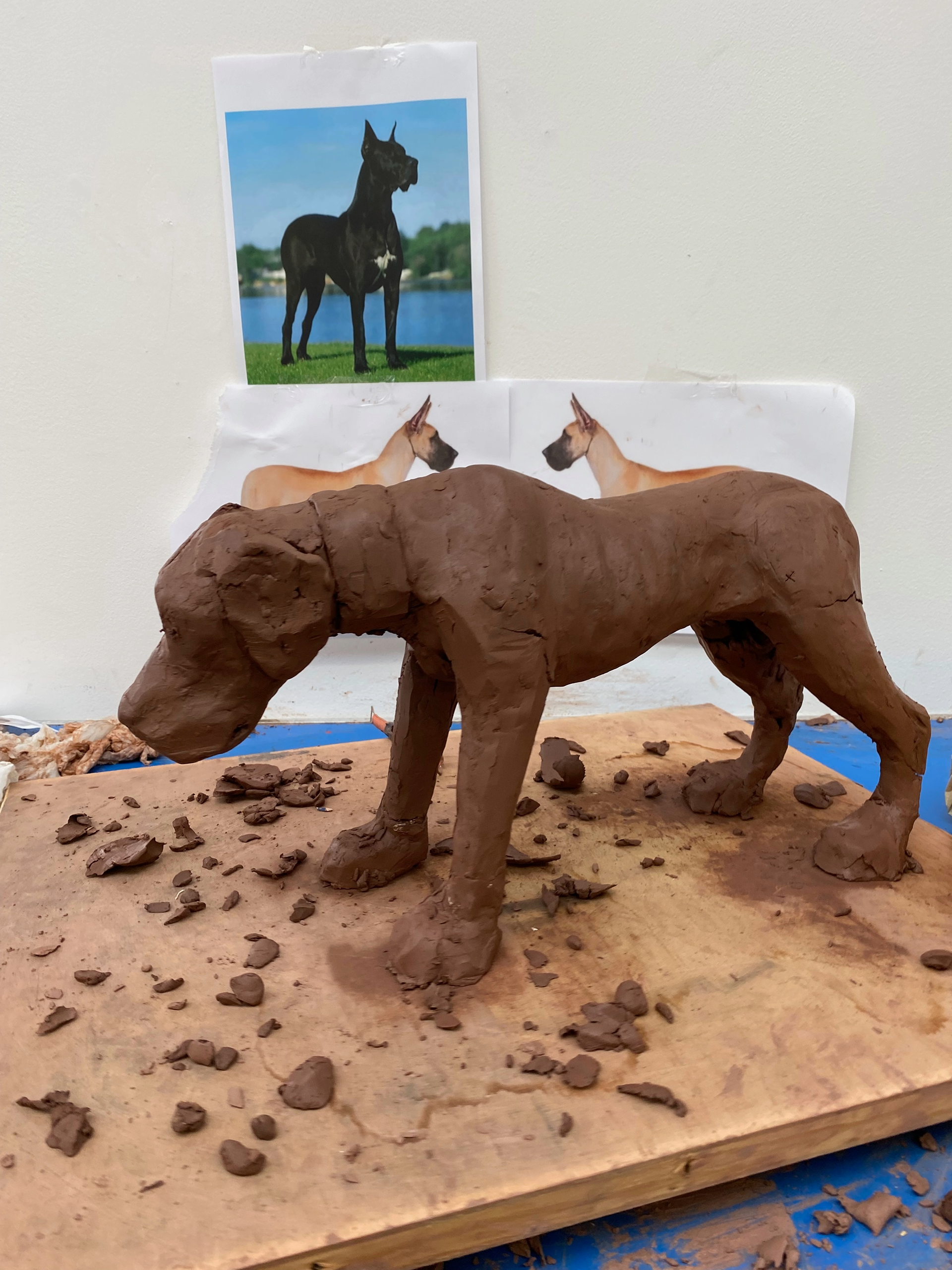
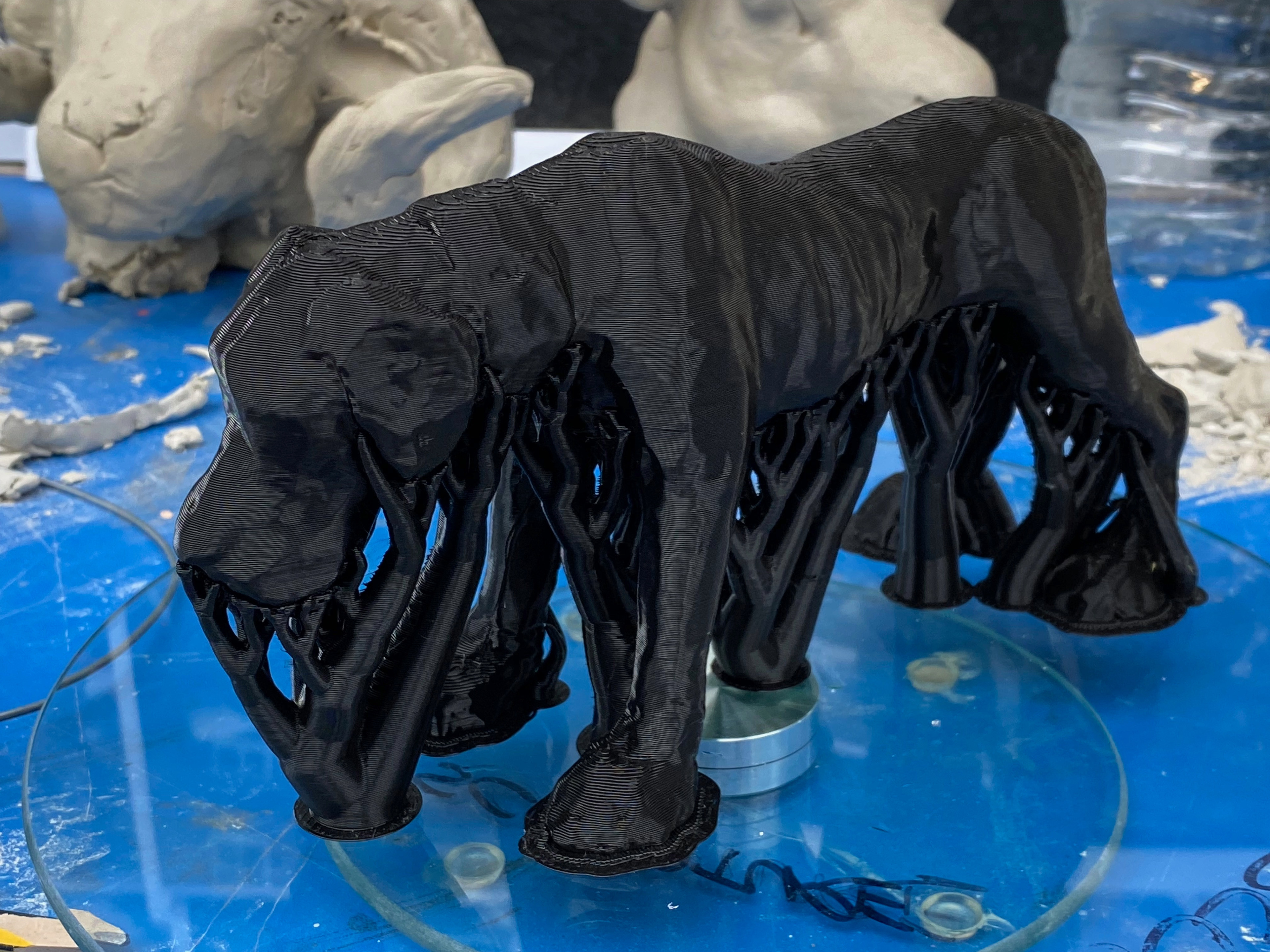
Malachi Wallace
Black dog in two parts
PLA Plastic
This project targets the manipulation of space by private entities to control and monitor how we utilize it. Specifically, metal studs placed on ledges to obstruct skateboarding, and pre-recorded sounds triggered by motion sensors to make it impossible to relax in a certain areas. The project questions the fetishization of relentlessly securitized infrastructures and what these represent in contemporary society.
Organic supports computed by the printing software are flora of our new digital landscape, print lines a topographical map. The black dog is an omen in English folklore, spirits of lost souls or harbingers of death, but not all black dog legends are malevolent. In some areas, these creatures are believed to protect travelers or serve as loyal companions to those who are in need of help, guiding them through dangerous or mystical situations. 3D printing has increasingly become a tool for commercial use in a realm away from fine art, print lines can devalue a work as they represent mass production or commercialisation. ‘Black dog in two parts’ tries to explore the material nature of 3D printing rather than shying away from it, and hopefully begs the question whether one mode of construction holds more value than the next.
